
- Helen Keller Center for deaf-blind children
- Therapy day centre ATENDI
- Greater Kruger National Park Game Reserve
- International Centre for stingless bees
- Swahili in Tanzania and Zanzibar - ONLINE POSSIBLE!
- Hindi Lessons in Jaipur - ONLINE POSSIBLE!
- English at the University of Cape Town
- English in Jaipur, India
- English in Zanzibar
- Japanese in Tokyo
- Japanese on Sado Island - ONLINE POSSIBLE!
- Chinese in Beijing
- French in Morocco - also ONLINE!
- Spanish in Nicaragua
- Spanish in Bolivia - ONLINE AVAILABLE!
- Arabic in Morocco
- Indigenous languages
- Herbal medicine from Zanzibar herbalist - ONLINE POSSIBLE!
- Dhow Building in Zanzibar
- Coffee cultivation at Kilimanjaro
- Online Course: Wildlife Rehabilitation in the Amazon Rainforest
- Plucking tea in the Himalayas
- Learning Ayurveda in Cochin/Kerala
- Learning Kalaripayattu martial arts in Kerala
- Learning Kathakali theater and dance in Cochin/Kerala
- South Indian cooking lessons in Kerala
- All Online Courses
- 7 Days World Adventure in Zanzibar
- 14 Days World Adventure in Zanzibar
- 21 Days World Adventure in Zanzibar with Tanzania Safari
- 14 Days World Adventure in Tanzania
- 21 Days World Adventure in Tanzania
- 21 Days World Adventure in Tanzania with Trip to Zanzibar
- 14 Days World Adventure in the Himalayas
- 14 Days World Adventure Bolivia Altiplano
- 24 Days World Adventure Galapagos on 3 Islands
- Living with the Maasai!
- Camel Safari with the Maasai
- Tribal Villages in Maharashtra - the hidden India
- Tea program in Munnar/Kerala
- Country life and nature of the Rif Mountains
- Community Tourism at the Volcano Mombacho
- Changemaker's Journey - Meet Social Entrepreneurs in India
- Intercultural Training for Groups in China, India and Bolivia
- Examples for Study Tours
- Working Holiday in Berlin (Germany)
- Au Pair in Ireland (Short-time possible!)
- Farmwork in Ireland
- Horse ranches in Ireland
- Tourism and Hospitality Jobs in Ireland
- English language teacher jobs in China
- Working Holiday in Tokyo & Japan
- Farm work in Japan
- Ryokan Hotel Jobs in Japan
- Ski Resort Jobs in Hokkaido (Summer and Winter)
- Working Holiday on Sado Island
- FAQs Working Holiday in Japan
- Our Working Holiday in Japan Blog

Dissertations/theses abroad
Intercultural skills, career counselling.
- Accommodation
- Image galleries Africa
- Image galleries Asia
- Image galleries Middle East and Maghreb
- Image galleries Latin America
- About World Unite!
- The World Unite! Team
- Why with World Unite? - Our advantages
- Our principles
- Our contribution to sustainability
- Only for young people?
- Opinions/Testimonials
- Positions with World Unite!
- Do you have the right attitude?
- Dangerous developing countries?
- Culture shock
- Voluntourism and cultural exchange
- Child protection when volunteering
- Funding / Scholarships
- Insurances for your time abroad
- How to write a CV/resume
- Labdoo & Pack for a Purpose
- World Unite! on Facebook
- Volunteering with wildlife projects - what you should know!
- Postcolonialism - See the world with different eyes!
- Why pay to volunteer?
- Finding a permanent job abroad
- Interview with Chris Engler, World Unite! founder
- Interesting Links

- Volunteering & Interships Intro
- Kindergartens & primary schools in Zanzibar Town
- Kindergarten, primary school, education centre in rural Zanzibar
- Kindergartens in Moshi
- Teaching at schools in Moshi/Kilimanjaro
- Teaching English and vocational skills to youth in Zanzibar
- Primary Schools & kindergartens at township in Port Elizabeth
- Kindergarten & Afterschool Care in Township of Cape Town
- Teaching at schools in Cape Coast
- Kindergarten in Tangier
- Eco school in Morocco
- Kindergarten in Tamra
- Primary and secondary schools in Tamra
- Teaching underpriviliged children in Rajasthan
- English Medium Schools and Kindergarten in Navi Mumbai
- Community kindergarten "Los Ositos"
- Public School in León
- Mobile library and informal education for children in León
- Teaching and Childcare in Cochabamba
- Community Work in rural Bolivia
- Teaching sports & crafts - School in La Paz
- Childcare and education in Tokyo
- Remote Internships
- Social work with children in Moshi Town
- Social Work with children in Cape Town
- Municipal children's home in Tangier
- Don Bosco centres for street children in Kerala
- Children of the landfill
- Las Tías day care centre
- Afterschool care and holiday club for children
- Day centres and schools for Special Needs Children
- Centres for Special Needs Children in Cape Town
- Schools for Special Needs Children in Cape Coast
- Special Education in Navi Mumbai
- Helen Keller Centre for deafblind children
- Special Needs Children education and therapies in Cochin
- School and day centre for children with disabilities
- Network against female genital mutilation
- Social work and development work with women at Kilimanjaro
- Education for women in Tangier
- Empowerment of women and girls in Rajasthan
- Empowerment and education in Gurgaon
- Legal, psychological and social counselling children & women
- Protection and development for girls from difficult backgrounds
- Social Work in Tanzania
- Social Work in a township of Port Elizabeth
- St. Jude Home for children with cancer
- Social Work, Nursing and Medicine at Buddhist centre
- Tamra Senior Centre
- Home for the elderly "San Vicente de Paul"
- Residential home for adults with physical impairments
- Social Work, Healthcare and Physiotherapy in Malta
- Women's rights, Human rights, legal consulting
- Legal Support & Capacity Building for refugees in Cape Town
- Coalition against Racism
- Victims of State Violence - human rights and psychotherapy
- Mnazi Mmoja Hospital Zanzibar
- Mkoani Hospital on Pemba Island
- Mount Meru Hospital in Arusha
- Hospitals and medical centres at Kilimanjaro
- Muhimbili National Hospital Dar-es-Salaam
- Bugando Medical Centre Mwanza
- Hospitals in Cape Coast
- Hospitals in Tangier
- Charitable medical and nursing centre in Tangier
- Hospitals in Navi Mumbai
- Electives, pre-medical, pre-nursing in Jaipur
- Fatima Hospital in Cochin/Kerala
- Ayurveda internships in Jaipur
- Hospitals in León
- Charitable medical and nursing centre
- Hospital Arco Iris in La Paz
- Electives, (pre-)medical/nursing internships in Cochabamba
- Psychiatric Hospital and Sober House Zanzibar
- Lutindi Mental Hospital
- Psychology internships in Moshi
- Psychological Centre in Cape Town
- Psychology Internship: Developmental, organizational, clinical psychology
- Psychology internship in Jodhpur
- Drug rehabilitation and psychiatrist in Cochin/Kerala
- Psychology/psychiatry MGM Hospitals Navi Mumbai
- Psychology Internship: Special Education School in Jaipur
- Psychiatric Hospital Ankaful
- Mother Nature Conservation Camp Zanzibar: Rain Forest and Beach
- Mother Nature Climate Change Camp Kilimanjaro
- Domestic animal protection in Zanzibar
- Sustainability in Zanzibar - Waste, farming
- Veterinarian at Kilimanjaro
- Penguin and Seabird Rescue Centre
- Vervet Monkey Sanctuary & Rehabilitation
- Big 5: Game Reserve at Kariega River
- Zandvlei Estuary Nature Reserve near Cape Town
- Animal shelter in Cape Town
- Horse Ranch on the beach in South Africa
- Tsavo National Park - work with wildlife rangers
- Kakum National Park
- Environmental conservation, ecology, sustainable rural development in Morocco
- Animal Rescue and Awareness Raising Animal Welfare in Jaipur
- Environmental technology and management in Navi Mumbai
- CIMAC - Environmental education and park in León
- Gaia Pacha - Environmental technologies, education and research
- Animal conservation and care in the Amazon Rainforest
- Mother Nature Conservation Camp Sado Island
- Protection of Asian Black Bears in Karuizawa
- Dog Shelter in Tokushima
- Reduction of plastic waste
- Animal Shelters and Domestic Animals in Ireland
- Eco centre in Ireland
- Microfinance - Village Community Banks at Kilimanjaro
- Business internship in India
- Business Internships in China
- Logistics internship in China
- Marketing Internships in China
- Business and Media Internships: Startups in Tokyo
- Business internships in Ireland
- Dhow Countries Music Academy
- Cultural Arts Centre Zanzibar
- Stone Town Heritage & National Museum
- Youth club and manga art in Tangier
- Pantomime with castless women in Jodhpur
- Fashion Design Internship in Jaipur
- Sustainable Handcrafts from Myanmar
- Community Centre - work with children and youth
- House of Culture León
- TV Internship in Dar-es-Salaam
- Print media & journalism internships in Dar-es-Salaam
- Marketing, Communications, PR for Social Enterprises & NGOs in Cape Town
- Graphic Design and Media Production Internships in India
- Journalism internships in India
- Print and audio media for visually impaired
- Media and journalism internships in China
- Hotel internships in Zanzibar
- Internship safari lodges, camps and hotels
- Social Reality Tour tourism development and marketing
- Sustainable community tourism development in Zanzibar
- Tourism internship with a surf tour operator in Cape Town
- Hotel internship in South Africa
- Hotel internships in Ghana
- Hotel internship in Kerala
- Tour operator in New Delhi
- Hotel or tourism internship in Myanmar
- Hotel internships in China
- Sustainable tourism development and marketing in Nicaragua
- Tour Operator internship
- Internship Ecotourism & Outdoor Tourism in National Parks
- Tourism and Hospitality Internships
- Computer teacher Moshi Institute of Technology
- Vocational training teacher: Metal, wood, engineering
- Solar technology in farming and everyday life
- Architecture internship in Arusha
- IT Internships in India
- Engineering Internships in India
- Architecture internship in Navi Mumbai
- Urban development and building conservation in Yangon
- IT Internships in China
- Architecture internship in Tangier
- Engineering Internships and Technical Traineeships in Malta
- Agricultural Production and Training Centre in Tanzania
- Tropical organic farming in Zanzibar
- Tree nursery at Kilimanjaro
- Organic Farms in Israel
- Tea and fruit plantation and tea production in the Himalayas
- Organic educational farm in Myanmar
- Cocoa plantation in Nicaragua
- Farms in Ireland
- Organic farms in Galapagos - agriculture and conservation
- Watersports centres in Zanzibar
- Football (soccer) and athletics coach in Zanzibar
- Sports coach for children and youth in a township
- Coaching sports in Ghana
- Coaching football (soccer) in Puerto Lopez
- Job Orientation Internship in Jaipur
- Job Orientation Internship in Zanzibar
- Job orientation internship in Tanzania
- Job orientation internship in Ireland
- Remote/Virtual internships: Overview - how it works!
- Volunteering & Interships Side Module
- World-Learner_Intro
- World-Learner Menu Column 1
- World-Learner Menu Column 2
- World-Learner_side
- Voluntourism-Intro
- Voluntourism Itineraries
- Nachhaltige Entdeckerreisen
- Voluntourism-Side
- Work & Travel Intro
- Work & Travel Menu Column 1
- Work & Travel Menu Column 2
- Work & Travel Side
- Academix Custom Mod 1
- Academix Custom Mod 2
- Academix Custom Mod 3
- Locations Intro
- Locations Col 1 Menu
- Locations Col 2 Menu
- Locations Side
- Info Menu Col 1
- Info Menu Col 2
- Info Menu Col 3
- Home for the elderly "San Vicente de Paul"
- We offer courses and learning opportunities on-site at our host countries and online programs . There are language lessons and selected courses teaching specific skills from our host countries .
Learning foreign languages
Further courses.

- World Adventure Tours combine Volunteering with exciting excursions and activities. Community Tourism allows you to stay with local people and do activities with them. Read more...
World Adventure Tours

- 21 Days World Adventure Zanzibar with Tanzania Safari
- Community Tourism

Special Interest Group Programs

- Intercultural Training for Groups in China, Japan, India, Bolivia & online
- World Unite! is your specialist for Working Holidays and Au Pair in Europe, Japan and China! Read more...
Working Holiday in Europe and China
Working holiday in japan.

Europe & Middle East & Maghreb
Latin america.

Please select what you would like to do, where and for how long!

Tribal Villages in Maharashtra - The Hidden India

Tribal Villages
Getting there, warli-village walvanda.

- Rice cultivation - Rice is a staple food in India. You work in the rice fields and plant seedlings, learn how to harvest the ripe rice and winnow the grains to separate the husk by vigorous shaking. You will learn about the history of rice and understand what hard physical work is needed to get the rice.
- Interactions with the Warli , to understand their traditions and culture
- Inspect a Warli-House
- Warli Art lessons from an artist. Understand Warli painting, that represents the various aspects of their life and the environment of the Warli. You can also make yourself a Warli painting, inspired by experiences from your own life.
- Tour of the Village
- Watch the quick and energetic Warli Dance, to the sounds of Tarpa, a traditional wind instrument of the Warli, which is made from a dried gourd.
- Competition in rice pounding
- Cooking class with the local women
- Chopping wood
- Traditional agricultural activities : Pounding and Winnowing Rice, Chopping wood, Grinding spices, etc.
- Sowing rice (June), Weeding (July), Rice transplanting (July-August), Harvesting (October)
Forest Village Dehna

Tribal Village in Maharasthra - The Hidden India
Other projects that might interest you:.
- Mother Nature Conservation Camp and Temple Stay on Sado Island/Japan
- Tea Program in Munnar, Kerala
- Country Life and Nature of the Rif Mountains
- Tea Plucking in the Himalayas
- Changemaker's Journey - Social Business in India
Travel Health Insurance
Getting to navi mumbai.

BOOK NOW OR INQUIRE!
- Participating Cooking Lessons
- Agriculture
- Learning Cultural Activities
- Learning Handcrafts
- Living with indigenous tribes/communities
Our Partners

A wide selection of internships in many countries. Read more...

Charitable placements worldwide. Read more...

Learn your host country's knowledge. Read more...

Your alternative holidays. Read more...

Dissertations, intercultural learning. Read more...

Working Holiday in Japan, China and Germany Read more...
World Unite!
- Contact us!
- Book or inquire
- Remote/Online Internships abroad
- CO2 Footprint: 10 trees per participant!
- Mother Nature Camps
Destinations
- South Africa
- Internships abroad
- Volunteering
- World Learner
- Active Travel
- Working Holidays
- Electives abroad
- Online courses
- Emigrating - The Country Check
- World Unite! (日本語版ホームページ)
Quick Poll!
Do you find on our website what you are looking for.
- Terms and Conditions
- Privacy Policy
Remember Me
- Forgot your password?
- Forgot your username?

A Complete Guide To Tribal Tourism
T he true beauty of India is not found in towns and cities. It belongs to the indigenous people. One of the most remarkable aspects of their culture is their tribal lifestyle, arts, crafts, and architecture. The multiplicity of tribals in India provides a profound insight into the ethnography and anthropology of these mystic tribes, fulfilling your ideological curiosity. Many of these tribes have their own customs, festivals, music, and ways of expressing themselves artistically. Tribal tourism allows visitors to learn about these varied cultures and their traditions. The tribal trips in India are extremely revitalizing and energizing.
Tribal tourism in India is a method to learn about the rich and diverse cultures of the indigenous peoples that reside throughout the country. There are around 600 tribal groups in India, each with its own language, religion, customs, and art forms. Some of India's most prominent tribal tourism locations include:
Odisha: Odisha has the most indigenous communities recognized as Scheduled Tribes of any state, with 62. You can visit the state's colorful weekly markets, historic rock paintings, distinctive tribal festivals, and breathtaking natural beauty. The Bonda, Dongria Kondh, Lanjia Saora, and Kutia Kondh are some of the tribes you may encounter.
Chhattisgarh : Chhattisgarh is home to 42 tribal groups, the majority of which are centred in the Bastar area. You may see amazing tribal art and craft such metal work, terracotta, wood carving, and painting. You can also participate in the lively Dussehra festival, which lasts 75 days and includes many rites and processions. The Gond, Maria, Bhatra, and Muria are some of the tribes you may encounter.
Northeast India - Northeast India is made up of eight states that border China, Myanmar, Bangladesh, and Bhutan. With over 200 tribal communities, it is one of India's most ethnically and culturally varied regions. This region's lush green hills, tea gardens, wildlife reserves, and monasteries can all be explored. You can also experience the tribes' music, dancing, cuisine, and costumes. You can interact with the Naga, Khasi, Mizo, and Garo tribes, among others.
Rajasthan : Rajasthan is famous for its forts, palaces, and deserts, as well as its regal past. However, it also contains a vibrant tribal culture that is frequently missed by tourists. You can tour the tribes' villages where they live in harmony with nature and wildlife. You can also marvel at their unique jewelry, tattoos, embroidery, and pottery. The Bhil, Meena, Garasia, and Rabari are among the tribes visible.
Maharashtra : Maharashtra is one of India's most industrialized and urbanized states. However, it also has a sizable tribal population in the Western Ghats and Vidarbha regions. You can find out about their history, problems, and accomplishments. Folk art forms such as Warli painting and Pinguli puppets can also be appreciated.
Tribal tourism in India is a rewarding experience that allows people to discover the hidden gems of indigenous history. We can secure the preservation of these unique cultures while also having a positive impact on tribal populations by embracing responsible tourism practices.
While meeting tourists' interests and needs is important, it is equally critical to be culturally attentive to native tribes and their surroundings. Development pressures resulting from tribal tourism should be anticipated and kept to a minimum in order to maintain the area's resources and avoid saturation of the destination so that the product and residents are not abused. All tourist plans should include locals, particularly indigenous young, by training and hiring them and encouraging them to engage in and benefit from the tourism industry. Tourists should be educated not only about tribal areas as tourist attractions but also about ways to help preserve native culture while enriching their vacation experience.
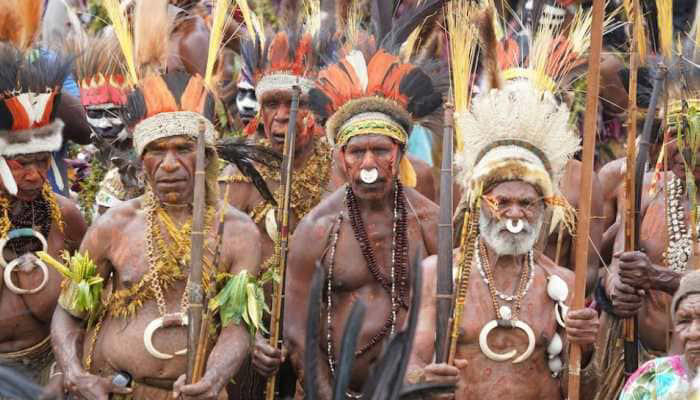
Boundless Explorism
Let your journey begin...
Jawhar: Exploring Maharashtra’s Tribal Culture on Mumbai Tours
Beyond the shiny veneer of Bollywood and the towering skyscrapers in Mumbai lies a rich tapestry of cultural diversity waiting to be explored. One such hidden gem is Jawhar, a small tribal town located just a few hours away from Mumbai. On your Mumbai sightseeing tour, don’t miss the chance to immerse yourself in the fascinating world of Maharashtra’s tribal culture.
Discovering Jawhar:
Jawhar is nestled amidst the lush green Western Ghats, making it an ideal escape from the chaos of Mumbai. The town is part of the Palghar district and is inhabited by several Adivasi tribes, including the Warli and Kukana tribes. These tribal communities have preserved their unique way of life, art, and traditions for centuries, offering a glimpse into a world that is rich in culture and history.
One of the most remarkable aspects of Jawhar’s tribal culture is its indigenous art form known as Warli art. Warli paintings are famous for their simplicity and depict the daily life, rituals, and traditions of the tribal communities. The art is primarily done using white paint on a mud background and often features scenes of farming, dancing, and tribal deities. Many local artists in Jawhar still practice this art form, and you can even try your hand at creating your own Warli painting during your visit.
Exploring Tribal Villages:
Jawhar offers visitors a unique opportunity to explore the lifestyle of the indigenous tribes. Your Mumbai sightseeing tour can include visits to various tribal villages, where you can interact with the locals and gain insight into their traditions. You might witness tribal dances, taste traditional cuisine, and learn about their agricultural practices. The warm hospitality of the tribal communities is sure to leave a lasting impression.
Historical Attractions:
While immersing yourself in tribal culture is a significant part of your visit to Jawhar, the town also boasts historical attractions that showcase its rich heritage. The Jai Vilas Palace, built by the tribal kings of Jawhar, is a stunning example of Indo-European architecture and a must-visit. The palace now houses a museum that displays the royal artifacts, paintings, and historical documents.
Nature’s Beauty:
The natural beauty of Jawhar is also a highlight of the trip. The town is surrounded by lush forests, waterfalls, and hills, making it an ideal destination for nature enthusiasts. The Dabdaba Falls, Kalmandavi Waterfalls, and Hanuman Point offer breathtaking views and great trekking opportunities. You can embark on short hikes, picnics, and birdwatching excursions in the serene surroundings.
Getting to Jawhar:
Jawhar is approximately 165 kilometers away from Mumbai, and it’s easily accessible by road. You can opt for a Mumbai tours package that includes transportation to and from Jawhar, making the journey hassle-free.
Conclusion:
While Mumbai is undoubtedly a vibrant city that never sleeps, a short detour to Jawhar on your Mumbai sightseeing tour can offer a refreshing contrast. Exploring Maharashtra’s tribal culture in Jawhar provides a unique and enriching experience that allows you to connect with the roots of the region. From Warli art to tribal villages and historical attractions, Jawhar is a treasure trove of cultural and natural wonders, waiting to be explored. So, take a break from the urban hustle and embark on a journey to discover the authentic heart of Maharashtra in Jawhar.
Add a Comment Cancel reply
Your email address will not be published. Required fields are marked *

- Deccan Odyssey
- Architecture
- Wild Safari
- Sanctuaries
- Travel Tips
Planning India tour? Enquire Now Get in touch with our Tour Planner
- Arrival * :
- Duration * : Select 1-3 Days 4-7 Days 8-14 Days 2-3 Weeks 3 Weeks">>3 Weeks
- Members * : Adults 1 2 3 4 5 6 Group Kids 1 2 3 4 5 Above 5
- Budget: Select Standard Economy Luxury
- Tour Style: Select Family Vacation Honeymoon Casual Vacation Business Traveller
- Other Specifics & Travel Plan:
Your Contact Information
- Country * : Select United States Australia New Zealand United Kingdom Canada Switzerland Solvakia Czech Republic -------------------------- Afghanistan Albania Algeria American Samoa Andorra Angola Anguilla Antarctica Antigua And Barbuda Argentina Armenia Aruba Ascension Island Australia Austria Azerbaijan Bahamas Bahrain Bangladesh Barbados Belarus Belgium Belize Benin Bermuda Bhutan Bolivia Bosnia And Herzegovina Botswana Bouvet Island Brazil British Indian Ocean Territory Brunei Darussalam Bulgaria Burkina Faso Burundi Cambodia Cameroon Canada Cap Verde Cayman Islands Central African Republic Chad Chile China Christmas Island Cocos (keeling) Islands Colombia Comoros Congo Cook Islands Costa Rica Croatia/hrvatska Cuba Cyprus Czech Republic Denmark Djibouti Dominica Dominican Republic East Timor Ecuador Egypt El Salvador Equatorial Guinea Eritrea Estonia Ethiopia Falkland Islands (malvina) Faroe Islands Fiji Finland France French Guiana French Polynesia French Southern Territories Gabon Gambia Georgia Germany Ghana Gibraltar Greece Greenland Grenada Guadeloupe Guam Guatemala Guernsey Guinea Guinea-bissau Guyana Haiti Heard And Mcdonald Islands Holy See (city Vatican State) Honduras Hong Kong Hungary Iceland India Indonesia Iran (islamic Republic Of) Iraq Ireland Isle Of Man Israel Italy Jamaica Japan Jersey Jordan Kazakhstan Kenya Kiribati Korea, Republic Of Kuwait Kyrgyzstan Latvia Lebanon Lesotho Liberia Libya Liechtenstein Lithuania Luxembourg Macau Macedonia (Yugoslav) Madagascar Malawi Malaysia Maldives Mali Malta Marshall Islands Martinique Mauritania Mauritius Mayotte Mexico Micronesia, Federal State Of Moldova, Republic Of Monaco Mongolia Montserrat Morocco Mozambique Myanmar Namibia Nauru Nepal Netherlands Netherlands Antilles New Caledonia New Zealand Nicaragua Niger Nigeria Niue Norfolk Island Northern Mariana Islands Norway Oman Pakistan Palau Palestinian Territories Panama Papua New Guinea Paraguay Peru Philippines Pitcairn Island Poland Portugal Puerto Rico Qatar Reunion Island Romania Russian Federation Rwanda Saint Kitts And Nevis Saint Lucia Saint Vincent & Grenadines San Marino Sao Tome And Principe Saudi Arabia Senegal Seychelles Sierra Leone Singapore Slovak Republic Slovenia Solomon Islands Somalia South Africa South Georgia Spain Sri Lanka St Helena St Pierre And Miquelon Sudan Suriname Svalbard & Jan Mayen Islands Swaziland Sweden Switzerland Syrian Arab Republic Taiwan Tajikistan Tanzania Thailand Togo Tokelau Tonga Trinidad And Tobago Tunisia Turkey Turkmenistan Turks And Caicos Islands Tuvalu Uganda Ukraine United Arab Emirates United Kingdom United States Uruguay Us Minor Outlying Islands Uzbekistan Vanuatu Venezuela Vietnam Virgin Islands (British) Virgin Islands (USA) Wallis And Futuna Islands Western Sahara Western Samoa Yemen Yugoslavia Zambia Zimbabwe
- Privacy Policy
* Mandatory fields
Cities of Maharashtra
- Telephone: +91 - 92268 72187
- E-mail: [email protected]
Registration is free and easy!
- Faster checkout
- Save multiple shipping addresses
- View and track orders and more
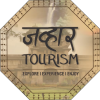
Jawhar — Land of Waterfalls and Tribal Heritage
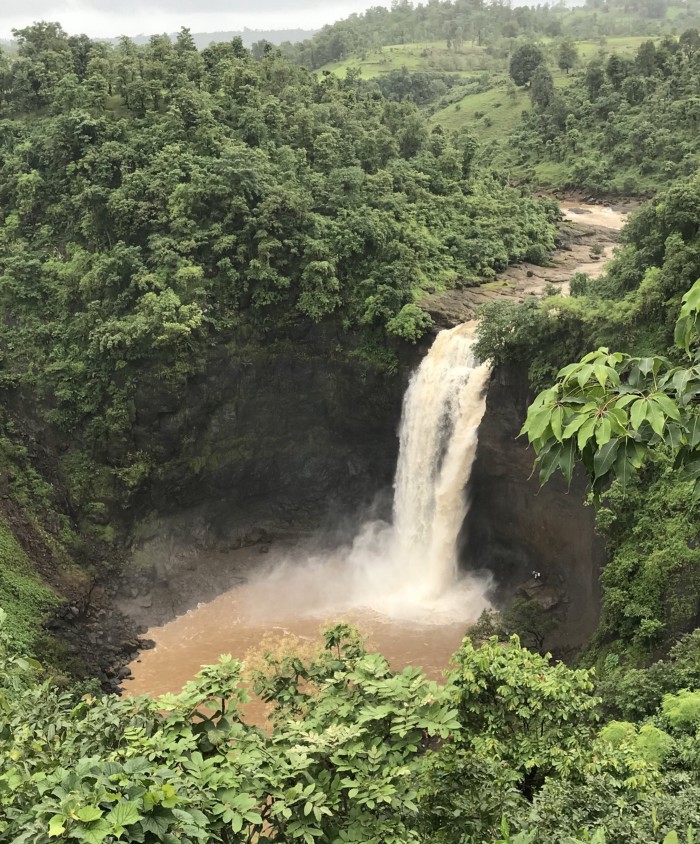
There are few adjectives that can rightly describe Sahyadri and Western Ghats in monsoon. While it is beautiful all year long, monsoon enhances its natural beauty to a sublime degree.
I got a chance to visit Jawhar recently, a quaint little tribal hill station in Maharashtra. It is known as one of the places to receive highest rainfall in the state and for its Warli paintings.
It is a village in tribal district of Palghar, in northern Maharashtra. It has 95% tribal population, with 30–40 types of tribes. They are deeply rooted to their culture, and exist in harmony with nature.
The journey to this rustic getaway was filled with greenery soothing our eyes. Paddy fields on either sides of road, dotted with tribal settlements, showed us a slow and scenic village life.
The final stretch was winding ghats, through green forests, and the temperature began to drop steadily.
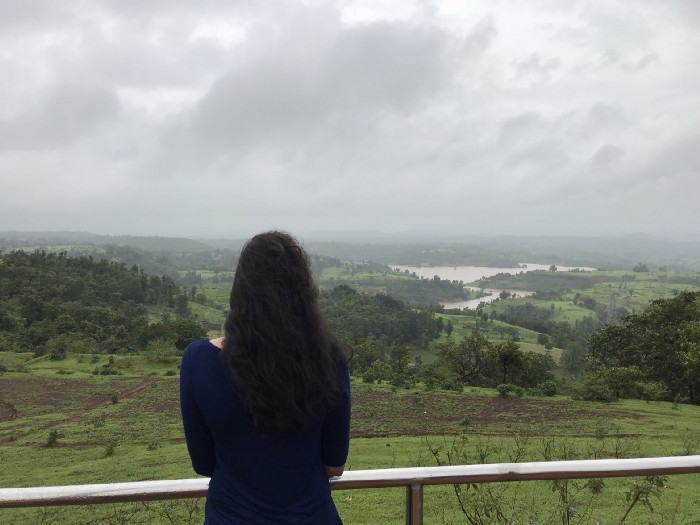
I first came across Jawhar when I was nine. My parents had one of their government offices there, and needed to report to a superior officer regularly. They’d tell us about how beautiful and unexplored the place is, about how their office was adorned with Warli paintings on the inside as well as outside. They even took us for a visit there! It was intriguing for us children to walk in a palace so old and see the possessions owned by the kings back in the day — their furniture, cribs, bathtub and piano! My favourite memory is that of walking through endless cashew nut plantations leading to the palace, and getting drenched in rain while watching the green valley at Hanuman point.
The region of Jawhar was ruled by Mukane dynasty from 14 thcentury. In their heyday, they ruled the region spreading from Silvassa in the north, to Bhiwandi in the south. Jawhar was always a part of Maratha empire and later became a part of the Bombay Presidency during the British rule.
Jai Vilas palace
This architectural heritage has a distinct charm, and is made in pink stone. Also called Raj Bari, it is located on a hill top, with view of hill ranges around.
The old palace is in ruins, and the new palace was made in 1940 and has 80 rooms. It is a nice experience to walk around the palace, which is nestled in 500 acres of cashew nut plantation.
The walls of the palace are adorned with paintings of king Yashwant Rao Mukne, his sons and wife.
We were shown the darbar, king’s and queen’s rooms, their children’s room which have wooden toys, and a telescope. Queen’s room had most furniture like bed, chairs, and tables in the shape of lotus.
The king no longer resides here. He stays in Pune and keeps visiting the place, the caretaker informed us. It is now rented out for film and TV show shooting.
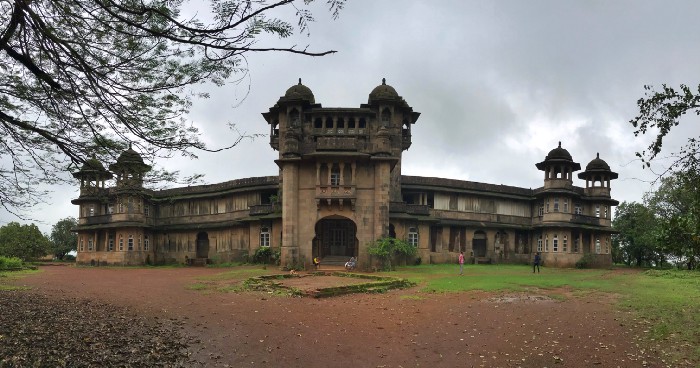
(In picture: Jai Vilas palace)
Waterfalls and Dams
Perhaps most famous for its waterfalls, Jawhar has plenty of them, namely Dabhosa, Kalmandvi, Domzira and Hiradpada
It also has beautiful dams like Jaisagar dam and Khad-khad dam, which draw many nature enthusiasts.
The most famous tourist attraction here is Dabhosa waterfall. The flow in the waterfall is astounding. It cascades down from a height of 300 feet, into a crater shaped bowl. The view of water rushing through dense forests and forming the waterfall is glorious!

(In pictures: Dabhosa waterfall, Khad-Khad dam, Kalmandvi waterfall — picture sourced from internet)
Hanuman point
Spending time at Hanuman Point was definitely refreshing! It has dense green valleys on three sides, with view of sheep grazing leisurely at a distance. Katya Maruti temple welcomed us to this place and the palace is visible on the right side amid greenery.
The place has a panaromic view of the surrounding area.
It is an ancient structure on top of the tallest hill, with a commemorative plaque inside describing Shivaji’s visit here. Shivaji Maharaj had camped with his army in Jawhar en-route Surat, and the king of Jawhar had welcomed him and put a feather in his crown.
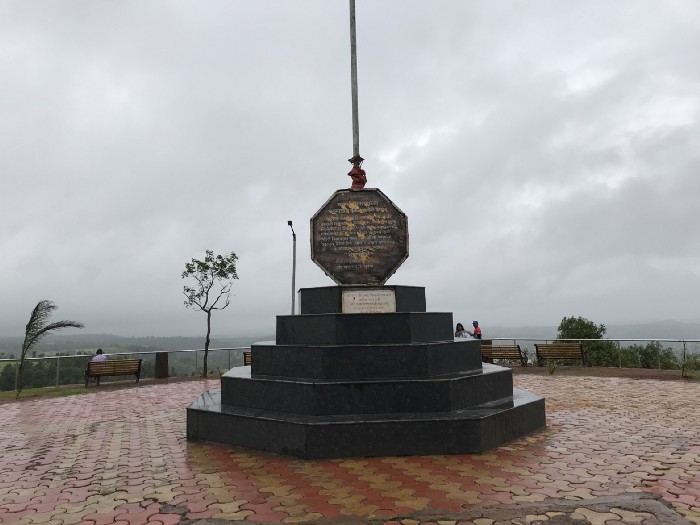
(In picture: Shirpamal)
Warli painting
We made our way back to the village, where most houses had beautiful Warli paintings on their walls and doors. We were taken to an artisans’s house, who not only showed us his beautiful Warli art collection made on cloth, but also generously taught us some basics of Warli paintings.
Famous for its vibrant Warli art, Jawhar is one of the few remaining tribal regions in Maharashtra. These artworks are themed around scenes from daily life like farming, fishing to celebrations like marriage, Tarpa dance and rainfall. My favorite is the one showing a peacock dancing in rain!
They are now made on other articles like coasters and bags as well, for the purpose of sale as souvenirs.
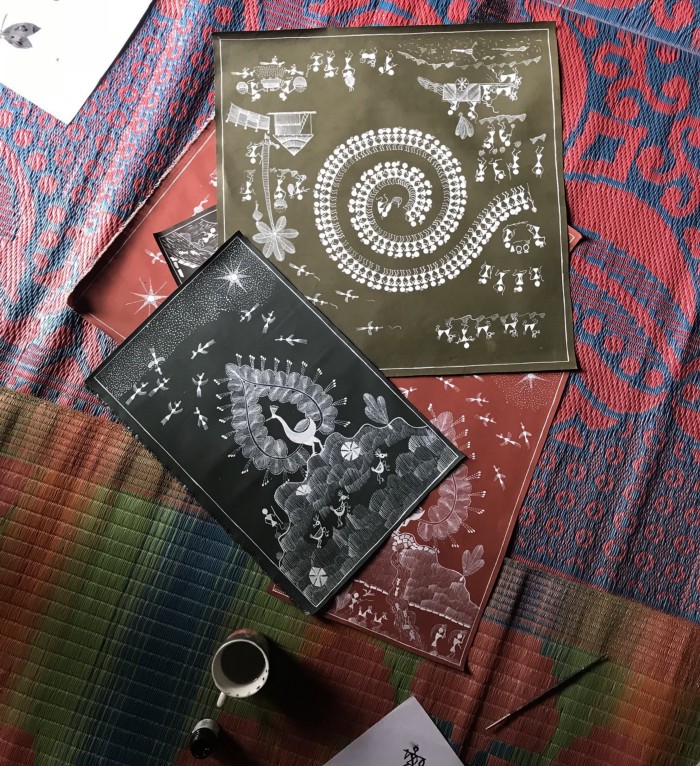
(In picture: Warli painting workshop)
Bhopatgad fort
It is a small fort on the outskirts of Jawhar. It was made during Shivaji Maharaj’s rule, and was used to hold formal meetings.
A popular legend about the fort is Lord Ram, with wife Sita, and his sons Luv and Kush visited this place, and four smooth rocks with four pair of foot prints are believed to be theirs.
Bohada festival
The famous Bohada is a mask festival of the tribal community in Thane and Nasik district, which happens in the month of April-May each year. It has celebrated with a display of individuals wearing 52 masks of Indian Gods and Goddesses, giving performances in a procession. The purpose of Bohada is so pay homage to village Gods and Goddesses, for creation and sustaining of life.
Jawhar is not just a land of lush greenery and beautiful waterfalls, but also rich culture. The tribal communities here have preserved their culture and traditions well. The efforts of local villagers to promote tourism and safeguard their culture are commendable. During our visit here, they offered us mouth-watering home cooked breakfast of poha, upma, egg bhurji and tea. My suggestion would be to spend more than one day here to soak in its homely vibe.
If you’ve read so far, thank you very much for your time.
About the Author
Related Post
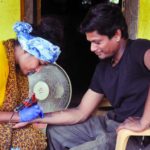
Tattoos to tell the tale

Jawhar’s Artists Turn (Sk)Inward

Team Trek – Jawahar Hill Station
Submit a review.
Click here to cancel reply.
Display Name
Our Visitor
Contact details.
Phone : +91 92268 72187 Email : [email protected]
jawhartourism

@jawhartourism
Follow on Instagram
Facebook feed
Jawhar Tourism
Enquiry Form
- JAWHAR HISTORY
- Tourist Attraction
- दिशादर्शकाकडे जा
- विषयाकडे जा

भारतरत्न डॉ. ए.पी.जे. अब्दुल कलाम अमृत आहार योजना
कोविड १९ - माझे कुटुंब माझी जबाबदारी
राज्य स्तरीय क्रीडा स्पर्धा 2016-17
आदिवासी विकास कार्यक्रमाची प्रभावी अंमलबजावणीकरण्याकरिता १९७६ मध्ये आयुक्तालायची स्थापना केली.
महराष्ट्रातील आदिवासी कल्याणासाठी आदिवासी विकास मंत्रालयाची स्थापना १९८४ मध्ये झाली
कायापालट अभियान
आदिवासी मुला-मुलींसाठी मदत कक्ष टोल फ्री क्रमांक
मुक्त निधी योजना
पि. ई. एस. ए. अंतर्गत ग्राम पंचायत साठी मुक्त निधी योजना
- आदिवासी विकास महामंडळ यांच्यामार्फत बांधकाम बाबत ई- निविदा
- आदिवासी विकास विभाग मध्ये कंत्राटी पद भरती जाहिरात प्रसिध्द करण्याबाबत.
- आश्रमशाळा महा-निरिक्षण कार्यप्रणाली विकसित करणेबाबत
- दरपत्रक- परदेशी शिष्यवृत्ती संगणक प्रणाली विकसित करणे
- आदिवासी विकास विभागांतर्गत क्वेस्ट कार्यालयाकरीता १० लॅपटॉप खरेदीसाठी दरपत्रके मागविणेबाबत
- आदिवासी विकास विभागांतर्गत क्वेस्ट कार्यालयाकरिता १० लॅपटॉप खरेदीसाठी दारपत्रके मागविणेबाबत.
- आदिवासी विकास विभाग सरळसेवा भरती -2023
- वाहन खरेदी करण्यासाठी अंतीम कोटेशन (प्रोफ़ार्मा इनव्हाईस) पाठविण्याबाबत
- अनुसूचित जमातीच्या मुला-मुलींना परदेशात शिक्षणासाठी शिष्यवृत्ती देणेबाबत (सन २०२३-२४)
- दरपत्रक सूचना - ई-ऑफीस अंमलबजावणीसाठी आदिवासी विकास विभागात 22 स्कॅनर्स (High Speed) खरेदीसाठी दरपत्रके मागविणेबाबत.
- शबरी महामंडळात वरिष्ठ सल्लागार नेमणूकीबाबत
- निविदेची सुचना - आदिवासी विकास विभागातील अधिकारी कर्मचाऱ्यांचे सेवापुस्तक डिजिटल सेवापुस्तक करणेबाबत
- आदिवासी विकास विभागातील निर्लेखित आयटी उपकरणांची निविदा पद्धतीने विल्हेवाट
- संगणक, प्रिंटरर्स, स्कॅनर्स, लॅपटॉप दुरूस्ती सेवा निविदा
- शबरी आदिवासी वित्त व विकास महामंडळ मर्या. जाहिरात बाह्य स्त्रोताद्वारे नेमणुकीकामी संस्था/कंपनी नियुक्ती बाबत... दिनांक ०७/०३/२०२२ पर्यंत मुदत वाढ
- निर्लेखित संगणक विक्रीबाबत
- एकलव्य मॉडेल रेसिडेंशियल स्कूल मधील शिक्षक/शिक्षकेत्तर कर्मचारी यांचे साठी सेवा भरती नियम (RR)लागू करणेबाबत.
- अनुसूचित जमाती मुले / मुलींसाठी परदेशी शिक्षणासाठी शिष्यवृत्ती योजना
- शैक्षणिक वर्ष २०२१-२२ करीत एकलव्य मॉडेल रेसिडेन्शिअल स्कूल (EMRS) साठी प्रवेश अर्ज ऑनलाईन पद्धतीने भरणेकरिता करावयाच्या कामासंदर्भात दरपत्रके मागविणे बाबत...
- शबरी आदिवासी वित्त व विकास महामंडळ मर्या., नाशिक – १५००० शेतकऱ्यांचे एफपीओ आयोजित करण्याच्या अंतर्गत प्रस्ताव मागवण्याची जाहिरात.
ई शिष्यवृत्ती
ऑनलाइन शिष्यवृत्ती व्यवस्थापन प्रणाली.
आदि 'प्रमाण' प्रणाली
आदिवासी अनुसूचित जमाती प्रमाणपत्र पडताळणी प्रणाली
पेसा ग्रामपंचायत पुस्तिका
आदिवासी साठी प्रमुख विविध योजना.
आदिवासी विकास बद्दल
आदिवासींच्या कल्याणाच्या योजनांची परिणामकारक अंमलबजावणी करण्यासाठी सन १९७२ मध्ये समाजकल्याण विभागांतर्गत आदिवासी विकास संचलनालयाची स्थापना करण्यात आली होती. त्यानंतर १९७६ साली आदिवासी विकास आयुक्तालय सुरु करण्यात आले. दि. २२ एप्रिल १९८३ रोजी स्वतंत्र आदिवासी विकास विभागाची स्थापना करण्यात आली आणि १९८४ पासून आदिवासी विकास विभाग स्वतंत्रपणे कार्यरत आहे. आदिवासी विकास विभागाच्या बळकटीकरणाकरिता सन १९९२ मध्ये आदिवासी विकास संचलनालय हे आदिवासी विकास आयुक्तालयात विलीन करण्यात आले.
आदिवासी विकास विभागांतर्गत ठाणे, नाशिक, अमरावती व नागपूर येथे चार अपर आयुक्त व २९ एकात्मिक आदिवासी विकास प्रकल्प कार्यालये असून त्यांच्या मार्फत मागासवर्गीय कल्याणाच्या राज्य व केंद्र शासनाच्या योजनांची अंमलबजावणी केली जाते. या योजनांतर्गत सामाजिक कल्याण, आर्थिक कल्याण... (अधिक माहिती)
अनुसूचित जमातीच्या मुला-मुलींसाठी शासकीय वसतीगृह योजना.
- अनुसूचित जमातीच्या मुला-मुलींना त्यांच्या गावाबाहेर राहून उच्च शिक्षण घेण सुलभ व्हावे याकरिता विभागामार्फत विभागीय स्तर, जिल्हास्तर, तालुकास्तर आणि ग्रामीणस्तरावर शासकीय वसतीगृहे कार्यान्वित आहेत.
- शासन निर्णय क्र.आवप्र-1204/प्र.क्र.52/का-12, दि.03.08.2004
- शासन निर्णय क्र.आवगृ-2011/प्र.क्र.171/का-12, दि.10.04.2013.
- सदर वसतीगृहांमध्ये इ.8 वी पासून पुढील अभ्यासक्रमांसाठी प्रवेश देण्यात येतो.
- प्रवेशित विद्यार्थ्यास निवास, आहार, आवश्यक शैक्षणिक साहित्य इत्यादी सोयी सुविधा मोफत पुरविण्यात येतात.
- योजनेंतर्गत अर्जाकरिता संकेतस्थळ :- http://swayam.mahaonline.gov.in
नवीन प्रकल्प

प्राथमिक शिक्षण सेवक (इंग्रजी माध्यम) स्पष्टीकरण

Direct Service Recruitment -2023 Corrigendum
शुध्दीपत्रक

Tribal Development Department Direct Service Recruitment -2023
ऑनलाईन अर्ज करण्यासाठी लिंक

Tribal Development Department Recruitment -2023
अनुसूचित जमाती प्रमाणपत्र तपासणी ऑनलाईन करण्यासाठी आदि प्रमाण प्रणाली.
अनुसूचित जमाती प्रमाणपत्र तपासणी ऑनलाईन करण्यासाठी आदि "प्रमाण" प्रणाली

आदिवासी मुलामुलींकरिता टोल फ्री क्रमांक १८०० २६७ ०००७

भारतरत्न डॉ.ए.पी.जे.अब्दूल कलाम अमृत योजना

व्हिडिओ कॉन्फरन्सिंग
विभागाने त्यांचा आधिपत्य खालील क्षेत्रिय कार्यालायाकरिता व्हिडिओ कॉन्फरन्सिंग सुविधा उपलब्ध केली आहे

हेल्पडेस्क सपोर्ट
Department launched Helpdesk to provide online support to all eScholarship and TCVIS beneficiaries. Helpdesk Number is 022-61 31 6 400

प. ए .स. ऎ. अंतर्गत ग्राम पंचायतींची मुक्त निधी योजना
- Government of Maharashtra
- Ministry of Tribal Affairs, Government of India
- Commissionerate, Nashik
टोल फ्री नंबर: 1800 2670 007
महत्वाच्या व्यक्ती
श्री. विजय वाघमारे (भा.प्र.से) सचिव, आदिवासी विकास विभाग
छायाचित्र दालन .

Modal title
Offbeat Tours to Take in India
India's Best Homestays
Palace Hotels in India
India's Coolest Treehouse Hotels
Top Wildlife & Jungle Lodges
The Best Hostels in India
Best Budget Hotels in India
Transport in India: An Overview
India's Major Airports
India's Best Airlines
Domestic Airlines in India
Hiring a Car & Driver in India
Your Intro to Indian Railways
Travel Classes on Indian Trains
How to Reserve a Train Ticket
How to Find & Board Your Train
Tips for Train Travel in India
India's Scenic Toy Trains
12 Indian Etiquette Don'ts
The Top 10 Indian Stereotypes
Tipping in India
What Does the Head Shake Mean?
9 Challenges You'll Face in India
How to Avoid Culture Shock
Top 5 Monsoon Health Concerns
Voltage Information for India
How to Use Your Cell Phone
How to Say Hello in Hindi
Often Misunderstood Hindi Terms
Hindi Language Books
Most Common Indian Scams
How to Handle Begging in India
How to Spot Fake Indian Currency
What to Buy in India
How to Buy a Sari in India
How to Bargain at Indian Markets
How to Get an Indian Visa
India's Visa Types, Explained
Applying for an E-Visa
India's Climate & Seasons
Monsoon in India
Your Essential Packing List
Things to Buy Before You Go
What to Pack for Monsoon
The Best India Guidebooks
How to Save on Your India Trip
The Top Destinations in India
The Most Iconic Sights in India
Which Region Is Right for You?
India's Top Historical Destinations
Romantic Indian Destinations
India's Top Hill Stations
India's Top National Parks
The Best Beaches in India
India's Best Backpacker Spots
India's Most Spiritual Destinations
The Best Luxury Spas in India
India Off the Beaten Path
India for Adventure Travelers
Where to Experience Rural India
The Top Things to Do in India
Palaces & Forts in India
India's Best Surfing Beaches
Volunteer on a Budget in India
7 Cool Sound & Light Shows
India's Most Popular Festivals
India's Best Bike Tours
See India by Motorcycle
India's Top Tribal Tours
Top 5 Places to Tour Tribal India
:max_bytes(150000):strip_icc():format(webp)/10947453_10153084623948270_8191342691038933499_o-591d1e8d3df78cf5fa731909.jpg)
India, along with Africa, has the largest tribal population in the world. The statistics are quite astonishing: the 533 different tribes, made up of more than 80 million tribals, represents almost 10% of India's population. The lives of the tribes in India are closely tied to nature, and they inhabit some of the most pristine and picturesque environments in the country. Largely unaffected by the modern world, they're very simple and often curious people, who have retained their rituals and customs. There's much to learn from them! Here are five of the best places to tour tribal India, and get an unforgettable insight into their existence.
Approximately 25% of Odisha's population is tribal and the state has more than 60 different tribes -- the largest number in India. These ancient people with mystical ancient ways dwell in Odisha's remote, deep forests and hilly interiors. Most of them are in the southwest part of the state. You'll need to go on an organized tour to visit the tribes in Odisha as some tribal areas are quite inaccessible and require permits, and language is also a barrier. Puri is the best place to arrange tribal tours. Tours run for at least five nights, due to the amount of travel involved.
- Tours: Heritage Tours operates a 7-day Tribal Wonders tour. Also try community-based Grass Routes Journeys in Puri, which run 13-day tribal trail tours . Desia is an inspiring community-based tribal tourism initiative in the Koraput Valley of Odisha. They offer tours. Alternatively, travel independently and stay at the boutique Chandoori Sai Guest House in the heart of tribal Odisha.
Chhattisgarh
Bordering Odisha, the small but cultural state of Chhattisgarh used to be part of Madhya Pradesh. Over a third of its population is tribal, with most of them living in the thickly forested areas of the Bastar region. The tribes are predominantly Gonds, with Dorla, Maria and Muria identities. The Gonds are known for producing beautiful art and having unorthodox marriage practices. Young men and women live together in groups in Ghotul huts and interact freely before getting married. The Dusshera festival is one of the most important festivals of the region and is celebrated in unique style there.
- Tours: India City Walks conducts an immersive and insightful 6-day Walk With Tribe tour in Chhattisgarh. Alternatively, leading Indian tour company Erco Travels offers a comprehensive 10-day Bastar Tribal Tour including sightseeing in Delhi. If you want to travel independently, stay at Kanker Palace for a regal experience. They organize tours to surrounding tribal villages.
Northeast India
There are 16 major tribes in untamed Nagaland , which shares a border with Myanmar in remote northeast India . Whether you venture to the villages just a few hours from Kohima, or to the far-off districts of Mon (renowned for having the last surviving head hunters) and Mokokchung, you're sure to be engaged by the fascinating tribal village life in Nagaland. Many people prefer to take an organized tour, but it's not a must if you're adventurous. The Hornbill Festival , held every December in the Kohima district, offers a popular tribal experience. Arunachal Pradesh, with tribes such as the Apatanis from Ziro, is also gaining interest from travelers as a tribal destination.
- Tours: Holiday Scout, based in Arunachal Pradesh, provides a comprehensive range of tribal tours of various lengths from one day to two weeks across northeast India. Greener Pastures conducts many different tribal tours including an epic 32-day Tribal Frontiers of Northeast India tour through Assam, Arunachal Pradesh, Meghalaya, and Nagaland. The Blue Yonder offers a customizable trip to visit the tribes of Assam and Arunachal Pradesh .
Around 15% of Rajasthan's population is tribal. The Bhil tribe, the predominant group, were among the original inhabitants of Rajasthan. They're mostly located in southern Rajasthan, and certain cities are named after their Kings who once ruled there. Don't miss the five-day Baneshwar tribal fair, held every January or February in Dungarpur. You can also celebrate the Holi festival in traditional style in Banswara with the Bhils. See them dressed in traditional clothing, carrying swords and sticks, and performing the tribal dance of the region.
Conveniently located not far from Jodhpur , Bishnoi village provides an authentic experience of rural Rajasthan. The notable Bishnoi tribe reveres nature and live in harmony with it, so much so that they bury their dead (instead of burning them like other Hindus) to preserve trees as wood is used in cremation.
- Tours: You can go on a Bishnoi Village Safari from Jodhpur. You'll be able to visit artisans such as weavers, potters and block printers, and spot wildlife. For a traditional stay, two of the best options are Chhotaram Prajapat's Homestay and Bishnoi Village Camp and Resort.
Maharashtra
Maharashtra has a large tribal population that inhabits different parts of the state but mostly hilly areas. The main tribes are the Bhils, Gonds, Mahadeo Kolis, Oraons, Katkaris, and Warlis. Like the Gonds, the Warlis are also renowned for their distinctive tribal art.
- Tours: Grassroutes , a community-based rural tourism venture, runs regular trips to Purushwadi village, home of the Mahadeo Koli tribe. The tribe lives in harmony with nature there, earning a living through farming. The village has just over 100 houses, and the majority of them welcome guests. So, you'll be able to stay with the tribal families and experience what it's like to live in a tribal village. The Mahadeo Kolis are extremely warm and friendly, and will happily continue their regular activities unmindful of visitors. Or, you can join in and help them! Alternatively, you can visit the Warli tribe in Walvanda village with Grassroutes, and participate in a Warli art workshop. Swadesee is another company that conducts regular visits to the Warli tribe.
15 Ways and Places to Experience Rural India
18 Farmstays in India to Get Back to Nature
20 Top Things to Do in Diverse India
17 Top Tourist Places to Visit in Rajasthan
16 Best Tourist Destinations in India
14 Famous Forts and Palaces in India that You Must See
12 Diverse Ways and Places to Celebrate Diwali in India
13 Exceptional Homestays in India
Top 13 Things to Do in Jodhpur, Rajasthan
India Travel: Issues to Know at Top Tourist Places
13 Popular North East India Festivals
12 Authentic Places to Buy Unique Handicrafts in India
What Handicrafts to Buy in India
The 14 Best Beaches in India
Guide to North East India States and Places to Visit
12 Major Mountain Ranges in India

How to Explore Tribal Tourism in India: Discovering the Rich Heritage of Indigenous Communities
- March 26, 2023
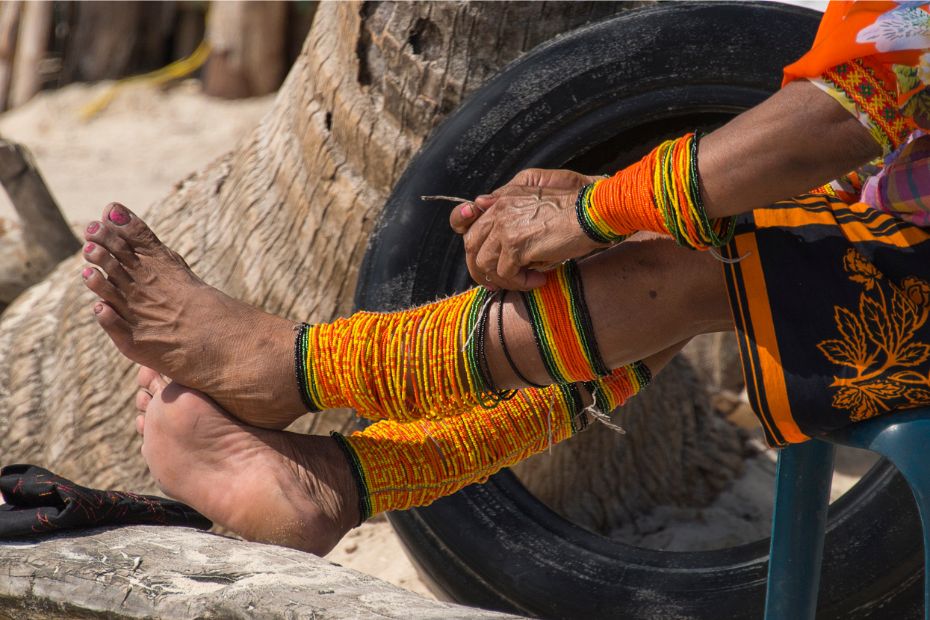
Explore the fascinating world of Tribal tourism in India, home to diverse indigenous communities. Learn about tips and watchouts for responsible travel while discovering captivating tribal festivals and cultural heritage.
India is a diverse country with a rich cultural heritage, and tribal tourism offers an opportunity to explore and experience the lives of various indigenous communities living in different parts of the country. Each tribe has unique customs, traditions, and art forms, offering a glimpse into India’s vibrant history and the incredible resilience of these communities. Here are some popular tribal tourism destinations in India:
- Bastar, Chhattisgarh: Bastar is home to numerous tribal communities, such as the Gonds, Marias, Murias, and Dhurwas. Visit the weekly markets, called ‘haats,’ to witness their vibrant culture and craftsmanship. The region is also famous for its distinctive handicrafts, such as bell metal, woodcraft, and terracotta work.
- Nagaland: Nagaland, in Northeast India, is home to more than 16 tribes, each with distinct customs and traditions. The annual Hornbill Festival showcases the state’s cultural diversity and is an excellent opportunity to witness traditional dances, music, and cuisine. Visit the villages of the Angami, Ao, Konyak, and other tribes to gain insight into their daily lives.
- Odisha: Odisha is known for its numerous tribes, such as the Bonda, Dongria Kondh, Saura, and Gadaba. Visiting the tribal villages, you can observe their unique customs, traditional houses, and agricultural practices. The region is also renowned for its tribal art forms, such as the Saura and Pattachitra paintings.
- Rajasthan: The Bhil and Meena tribes of Rajasthan have a rich cultural heritage, and their folk music and dance are integral to the region’s identity. Visit the villages in the Aravalli Hills to interact with the tribal communities and learn about their traditional art forms, such as pottery, weaving, and painting.
- Andaman and Nicobar Islands: The Great Andamanese, Onge, Jarawa, and Sentinalese tribes inhabit these remote islands. While visiting the Jarawa and Sentinalese is strictly prohibited to protect their way of life and prevent the spread of diseases, you can learn about the Great Andamanese and Onge tribes through museums and cultural centers.
- Ladakh: The nomadic Changpa tribe inhabits the remote high-altitude region of Ladakh. They are known for rearing pashmina goats and living in traditional yak-wool tents called ‘rebo.’ A visit to the Changthang region offers a glimpse into their unique lifestyle and the area’s breathtaking landscapes. Other tribes in Ladakh are Dard Aryans and Brokpa Tribe .
When participating in tribal tourism in India, choosing a responsible tour operator is essential to ensure the well-being of the communities and their environment. Always respect local customs and traditions, and engage in meaningful cultural exchanges that benefit travelers and the tribal communities.
Discovering Diversity: The Rise of Tribal Tourism in India
Tribal tourism in India has witnessed significant growth in recent years, driven by an increased interest in the country’s rich cultural heritage and a desire to explore its diverse indigenous communities. This rising trend can be attributed to several factors:
- Awareness and curiosity: The rise of the internet and social media has allowed people to learn more about the unique customs, traditions, and art forms of India’s various tribes. This has fostered a sense of curiosity among travelers who want to experience these cultures firsthand.
- Responsible tourism: As travelers become more aware of the impact of tourism on the environment and local communities, there is a growing demand for reliable and sustainable travel experiences. Tribal tourism offers an opportunity to engage with indigenous communities in a manner that respects their culture and supports their livelihoods.
- Government initiatives: The Indian government has recognized the potential of tribal tourism to promote sustainable development and has introduced initiatives to preserve the cultural heritage of tribal communities. This includes setting up Tribal Cultural Centers, organizing cultural festivals, and supporting the production and marketing of tribal handicrafts.
- Unique experiences: As the travel industry evolves, tourists increasingly seek immersive and authentic experiences that allow them to connect with local communities and cultures. Tribal tourism provides a unique opportunity for travelers to learn about the traditional way of life, art, and craftsmanship of India’s indigenous people.
- Community involvement: Many tribal communities actively participate in developing tourism in their regions, recognizing the potential for economic growth and cultural exchange. By welcoming visitors and sharing their traditions, they help preserve their heritage while fostering understanding and respect between different cultures.
Despite the rise in tribal tourism in India, ensuring that this growth is sustainable and does not adversely affect the indigenous communities’ environment, culture, and traditions is crucial. Travelers should choose responsible tour operators and engage in respectful and meaningful interactions with the local people. Through responsible practices, tribal tourism can continue to thrive, providing unique and enriching experiences for travelers and indigenous communities.
The Allure of India’s Indigenous Cultures: Tribal Communities Drawing Tourists Nationwide
India is home to diverse tribes, each with its unique customs, traditions, and art forms. Some of the most famous tribes that attract tourists due to their distinct cultures and lifestyles include:
- Bonda Tribe, Odisha: The Bonda people, residing in the remote hill regions of Odisha, are known for their colorful attire and distinctive beadwork. Tourists are drawn to their weekly markets to observe the vibrant Bonda culture and purchase beautiful handicrafts.
- Gond Tribe, Chhattisgarh, and Madhya Pradesh: The Gond tribe, found in central India, is renowned for its unique art form, the Gond painting. These paintings, characterized by intricate patterns and vivid colors, depict the tribe’s connection to nature and their beliefs. Visitors can learn about the Gond culture and purchase their artwork as souvenirs.
- Warli Tribe, Maharashtra: The Warli tribe is famous for its distinctive geometric art, known as Warli paintings. These paintings, created using rice paste on mud walls, depict scenes from daily life and cultural events. Tourists are attracted to the simplicity and elegance of Warli art and the opportunity to learn about the tribe’s customs and traditions.
- Toda Tribe, Tamil Nadu: The Toda people, who inhabit the Nilgiri Hills in Tamil Nadu, are known for their unique architectural style and traditional embroidery. Their huts, with barrel-shaped roofs, are a testament to their exceptional craftsmanship. Tourists are drawn to the Toda culture, particularly their expertise in creating intricate shawls and garments.
- Konyak Tribe, Nagaland: The Konyak tribe is one of the most prominent tribes in Nagaland, known for their colorful attire, intricate beadwork, and traditional tattoos. The annual Hornbill Festival showcases the Konyak culture and other Naga tribes, offering tourists a chance to witness their traditional dances, music, and handicrafts.
- Rabari Tribe, Gujarat, and Rajasthan: The Rabari people, a nomadic tribe primarily residing in Gujarat and Rajasthan, are known for their intricate embroidery and mirror work. Tourists are attracted to the Rabari culture due to their vibrant clothing, elaborate designs, and traditional craftsmanship.
- Mishing Tribe, Assam: The Mishing tribe, living in the riverine areas of Assam, is known for their stilt houses and traditional weaving techniques. Tourists visiting Mishing villages can learn about their way of life, participate in cultural events, and purchase handwoven textiles as souvenirs.
These are just a few examples of the many tribes in India that attract tourists with their unique cultures and traditions. When visiting tribal communities, respecting their customs and practices and engaging in responsible tourism that benefits both the indigenous people and the environment is essential.
The Positive Impact: Unraveling the Advantages of Tribal Tourism
Tribal tourism, when approached responsibly and sustainably, offers several benefits for indigenous communities and travelers. Some of these benefits include:
- Cultural preservation: Tribal tourism encourages indigenous communities to maintain and celebrate their unique customs, traditions, and art forms. As they share their heritage with visitors, they foster a sense of pride and appreciation for their culture, promoting its preservation for future generations.
- Economic development: Tribal tourism can contribute to the local economy by creating job opportunities and providing a source of income for indigenous people. This includes employment in tourism-related services, sales of handicrafts and traditional products, and the development of community-based tourism initiatives.
- Sustainable development: By promoting responsible tourism practices, tribal tourism can support sustainable development in indigenous regions. This includes conserving natural resources, protecting cultural heritage, and developing infrastructure and services that benefit both the local community and visitors.
- Education and awareness: Tribal tourism allows travelers to learn about diverse cultures, traditions, and lifestyles. This increased understanding can lead to greater tolerance and respect for different cultures, promoting social harmony and fostering global awareness of indigenous issues.
- Cultural exchange: Through interactions with indigenous communities, travelers and locals can engage in meaningful cultural exchange. This exchange can lead to a better understanding of different perspectives, values, and ways of life, fostering mutual respect and appreciation.
- Empowerment of indigenous communities: Tribal tourism can empower indigenous communities by giving them a voice and an opportunity to participate in the decision-making processes related to tourism development in their regions. This involvement helps ensure that the benefits of tourism are shared equitably and that the area’s unique cultural and environmental characteristics are preserved.
- Environmental conservation: Tribal tourism often promotes eco-friendly practices, such as the use of local and sustainable materials, waste reduction, and the preservation of natural habitats. This focus on environmental conservation benefits not only the indigenous communities but also the planet as a whole.
To maximize these benefits, travelers must engage in responsible tourism practices, such as choosing ethical tour operators, respecting local customs and traditions, and supporting the local economy by purchasing directly from artisans and service providers. By doing so, tribal tourism can continue to provide enriching experiences for travelers while contributing positively to the well-being of indigenous communities and their environment.
Responsible Explorations: Essential Tips for Travelers in Tribal Tourism
When embarking on any journey, travelers need to be prepared, responsible, and respectful. Here are some general tips that can help ensure a positive and enriching travel experience while also being mindful of the environment and local communities:
- Research your destination: Before traveling, research the culture, customs, and history of your destination. This will help you better understand the local context and make your trip more enjoyable and meaningful.
- Choose responsible tour operators: Opt for tour operators that prioritize responsible and sustainable tourism practices. Ensure they work closely with local communities and commit to protecting the environment and cultural heritage.
- Be respectful of local customs and traditions: Dress modestly and follow any cultural norms and etiquette when visiting places of worship, interacting with locals, or attending cultural events. Always ask permission before taking photographs of people or sacred sites.
- Learn a few phrases in the local language: Familiarize yourself with basic phrases and greetings in the local language. This will enhance your travel experience and demonstrate respect and appreciation for the local culture.
- Minimize your environmental impact: Practice eco-friendly habits, such as conserving water and energy, using reusable bags and bottles, and disposing of waste responsibly. Avoid activities that harm the environment or exploit natural resources.
- Support local economies: Patronize locally-owned businesses, such as restaurants, accommodations, and shops. Purchase handicrafts and souvenirs directly from artisans to ensure your spending benefits the local community.
- Respect wildlife and natural habitats: When visiting natural areas or observing wildlife, maintain a safe distance and avoid disturbing the animals or their environment. Follow designated trails and adhere to any rules or guidelines set by park authorities or conservation organizations.
- Be flexible and patient: Travel can be unpredictable, and it is essential to approach any unexpected situation flexibly and patiently. Embrace the opportunity to learn from new experiences and adapt to different ways of life.
- Stay informed: Stay updated on local news, weather conditions, or safety advisories. Follow the advice of local authorities and be aware of your surroundings to ensure your safety.
- Share your experiences: Upon returning home, share your travel experiences with friends, family, and colleagues. This can raise awareness about responsible tourism practices and inspire others to be more mindful of their impact on the places they visit.
By following these tips, travelers can enjoy a more immersive and fulfilling travel experience while contributing positively to the well-being of the environment and the communities they visit.

Navigating Cultural Landscapes: Essential Watchouts for Conscious Tribal Tourism Travelers
When traveling, being aware of potential risks and challenges is essential to ensure a safe and enjoyable experience. Here are some watch-outs or precautions to consider while exploring new destinations:
- Local laws and regulations: Familiarize yourself with your destination’s local laws and regulations to avoid inadvertently breaking any rules. This may include restrictions on alcohol consumption, photography, or specific dress codes.
- Health and safety: Stay updated on health advisories, such as vaccinations or potential disease outbreaks, and take necessary precautions. Also, be aware of your destination’s altitude or climate, as it may affect your health, and take measures to acclimatize or protect yourself accordingly.
- Travel scams: Be cautious of common travel scams, such as overpriced taxis, counterfeit currency, or fraudulent tour operators. Research beforehand and use reputable services to avoid falling victim to these scams.
- Personal belongings: Keep your valuables, such as passports, money, and electronic devices, secure and discreet. Use a money belt or hidden pouch, and avoid displaying expensive items that may attract attention.
- Cultural sensitivity: Be aware of cultural norms and customs to avoid inadvertently offending residents. This may include gestures, body language, or topics of conversation that may be considered inappropriate or disrespectful.
- Food and water safety: To prevent foodborne illnesses, be cautious when consuming street food or drinking tap water in destinations with questionable sanitation standards. Opt for bottled or purified water, and choose freshly cooked food from reputable establishments.
- Emergency contacts: Keep a list of emergency contacts, such as the local police, ambulance services, or your country’s embassy or consulate, readily available in case of emergencies.
- Travel insurance: Purchase travel insurance that covers medical expenses, trip cancellations, lost luggage, and other potential issues. This will provide peace of mind and financial protection in case of unforeseen events.
- Transportation safety: Use reputable transportation services, and be cautious when using public transportation, especially at night or in unfamiliar areas. Ensure that safety standards are met, such as functioning seat belts and well-maintained vehicles.
- Environmental impact: Be conscious of your ecological footprint while traveling. Avoid activities that harm the environment, such as littering, disturbing wildlife, or contributing to overtourism in fragile ecosystems.
By keeping these watch-outs in mind and taking necessary precautions, travelers can minimize risks and enjoy a safer, more fulfilling travel experience while respecting local cultures and environments.
Cultural Showcases: India’s Diverse Tribal Festivities
India is home to numerous tribes with distinctive customs and traditions. Many of these tribes celebrate unique festivals that showcase their rich cultural heritage. Here are some notable tribal festivals in India that offer travelers an opportunity to experience the diverse indigenous cultures:
- Hornbill Festival, Nagaland: Held annually in the first week of December, the Hornbill Festival is a week-long cultural event that brings together various Naga tribes. The festival highlights traditional dances, music, handicrafts, and cuisine, providing a glimpse into the vibrant heritage of Nagaland’s indigenous communities.
- Aoling Festival, Nagaland: Celebrated by the Konyak tribe in Nagaland, the Aoling Festival marks the beginning of the agricultural year. The week-long event, held in April, features traditional dances, music, feasting, and rituals that seek blessings for a prosperous harvest season.
- Dree Festival, Arunachal Pradesh: The Apatani tribe of Arunachal Pradesh celebrates the Dree Festival in July to ensure a bountiful harvest. The festivities include traditional dances, music, and rituals, along with offering prayers and sacrifices to the agricultural deities.
- Bhagoria Festival, Madhya Pradesh: The Bhil tribe in Madhya Pradesh celebrates the Bhagoria Festival, also known as the Festival of Love, in March. The event features traditional music, dancing, and a unique marriage ritual where young men and women choose their life partners during the celebrations.
- Wangala Festival, Meghalaya: Celebrated by the Garo tribe in Meghalaya, the Wangala Festival is a harvest festival in November. The event is marked by the beating of traditional drums, vibrant dances, and rituals that honor the sun god and seek blessings for a prosperous harvest.
- Tarnetar Fair, Gujarat: The Tarnetar Fair, held annually in August or September, is celebrated by various tribes in Gujarat, including the Rabari, Bharwad, and Kolis. The fair is famous for its traditional dances, music, colorful attire, and unique matchmaking event where young men and women search for potential spouses.
- Karam Festival, Jharkhand: The Karam Festival is celebrated by several tribes in Jharkhand, including the Oraon, Munda, and Santhal tribes. The event, which takes place in September, revolves around the worship of the Karam tree and includes traditional dances, music, and rituals that seek blessings for a successful harvest.
These tribal festivals offer a unique opportunity for travelers to witness the diverse cultural heritage of India’s indigenous communities. When attending these events, it is essential to respect local customs and traditions and engage in responsible tourism practices that support the preservation of these vibrant cultures.
Safeguarding Cultures: Preventing Abuse in Tribal Tourism
While tribal tourism offers numerous benefits for travelers and indigenous communities alike, it can also give rise to various challenges and abuses if not managed responsibly. Some of the potential issues include:
- Cultural exploitation: In some cases, tribal tourism can commodify indigenous cultures, reducing them to mere tourist attractions. This can result in the distortion or trivialization of cultural practices and traditions.
- Loss of privacy: The influx of tourists into indigenous communities may disrupt the daily lives of locals, infringing on their privacy and causing discomfort.
- Environmental degradation: Increased tourism in tribal areas can contribute to environmental issues, such as pollution, waste accumulation, and damage to natural resources.
- Economic disparity: While tribal tourism can generate income for some community members, it may also exacerbate economic inequality if the benefits are not equitably distributed.
To address these challenges and promote responsible tribal tourism, the following solutions can be considered:
- Community involvement: Engage indigenous communities in decision-making regarding tourism development in their regions. This will ensure that their needs, interests, and concerns are considered and that the benefits are shared equitably.
- Cultural sensitivity training: Train tourists and tourism service providers on cultural sensitivity and responsible travel practices. This will help ensure that interactions between visitors and locals are respectful and mutually beneficial.
- Sustainable tourism practices: Promote eco-friendly practices in tribal tourism, such as waste reduction, resource conservation, and local and sustainable materials.
- Support for local businesses: Encourage tourists to patronize locally-owned businesses, such as accommodations, restaurants, and shops, to ensure that the economic benefits of tourism are felt throughout the community.
- Regulations and guidelines: Develop and enforce regulations and guidelines for responsible tribal tourism, including limits on visitor numbers, restrictions on photography and filming, and the protection of sacred sites and cultural practices.
- Education and awareness: Raise awareness among travelers about the importance of responsible tourism and the potential impact of their actions on indigenous communities and the environment.
By implementing these solutions, it is possible to mitigate the potential abuses associated with tribal tourism and ensure that it remains a positive force for preserving and promoting indigenous cultures and their environments.
Sustainable Horizons: Shaping the Future of Tribal Tourism
The future of tribal tourism hinges on the responsible development and management of this growing travel niche. As interest in authentic, immersive, and culturally-rich experiences continues to rise, the potential for tribal tourism to expand is significant. However, to ensure a sustainable and equitable future, several key factors must be considered:
- Sustainable growth: Tourism stakeholders, including governments, private sector operators, and indigenous communities, must collaborate to promote sustainable development in tribal tourism. This includes balancing the economic benefits of increased tourism with the need to preserve cultural heritage and protect the environment.
- Community empowerment: Ensuring that indigenous communities have a voice in decision-making processes and benefit equitably from tourism revenue is crucial for the long-term success of tribal tourism. By empowering these communities, they can preserve their cultural identity and maintain control over their resources and development.
- Education and capacity building: Providing education and training for indigenous communities to develop tourism-related skills, such as hospitality, guiding, and handicraft production, can help enhance the quality of the tourism experience while creating sustainable livelihood opportunities for community members.
- Responsible marketing: Promoting tribal tourism in a way that respects cultural sensitivities and avoids stereotyping or commodification is essential. Marketing efforts should foster understanding, appreciation, and responsible engagement with indigenous cultures.
- Collaboration and partnerships: Establishing partnerships between governments, NGOs, private sector operators, and indigenous communities can facilitate the sharing of knowledge, resources, and best practices for responsible and sustainable tribal tourism development.
- Adaptive management: As tribal tourism evolves, it is crucial to continually monitor and evaluate tourism’s impacts on indigenous communities and the environment. This will allow stakeholders to adapt their strategies and practices to ensure the ongoing sustainability and cultural preservation of tribal tourism.
In conclusion, the future of tribal tourism is promising, provided stakeholders collaborate to promote responsible and sustainable practices. By prioritizing the well-being of indigenous communities and preserving their cultural and environmental heritage, tribal tourism can continue to offer enriching experiences for travelers while contributing to the socio-economic development of these unique communities.
Global Tapestry: Exploring Tribal Tourism Destinations Beyond India
Tribal tourism is not limited to India; numerous destinations worldwide offer travelers opportunities to explore and engage with indigenous cultures. These experiences allow visitors to learn about diverse traditions and lifestyles while contributing to preserving and promoting cultural heritage. Here are some notable examples of tribal tourism beyond India:
- Maasai communities, Kenya and Tanzania: The Maasai people, known for their distinctive attire and semi-nomadic lifestyle, welcome visitors to their villages in Kenya and Tanzania. Travelers can learn about their customs, participate in traditional ceremonies, and join them on guided wildlife safaris.
- Huaorani people, Ecuador: In the Amazon rainforest of Ecuador, the Huaorani people offer immersive experiences that provide insight into their traditional way of life. Visitors can explore the rainforest with Huaorani guides, learn about their hunting techniques, and discover their deep connection to the environment.
- Aboriginal tourism, Australia: Australia’s indigenous Aboriginal communities offer various cultural experiences, including guided walks, art workshops, and storytelling sessions. These encounters enable travelers to learn about the Australian Aboriginal people’s rich history, spirituality, and traditions.
- Native American experiences, United States: In the United States, numerous Native American tribes offer cultural backgrounds, ranging from guided tours of historical sites to traditional dance performances, art exhibitions, and craft workshops. Travelers can explore these indigenous peoples’ diverse cultures and histories across the country.
- San people, Botswana and Namibia: The San, or Bushmen, of southern Africa, are known for their intimate knowledge of the Kalahari Desert and their hunter-gatherer lifestyle. Visitors can join San guides on tracking expeditions, learn about their traditional survival skills, and gain insights into their unique culture and connection to the land.
- Ainu people, Japan: The Ainu, an indigenous people of northern Japan, offer cultural experiences that showcase their unique traditions and customs. Travelers can visit Ainu villages, participate in traditional crafts workshops, and learn about the Ainu’s deep respect for nature.
These examples illustrate the wealth of tribal tourism opportunities available beyond India. When engaging in these experiences, travelers must practice responsible tourism by respecting local customs, supporting indigenous-owned businesses, and being mindful of their impact on the environment and communities. In doing so, they contribute to preserving and appreciating these unique cultures while enjoying a deeper and more meaningful travel experience.
Demystifying Tribal Tourism: Essential FAQs for Inquisitive Travelers
Here are some frequently asked questions (FAQs) about tribal tourism to help travelers better understand this unique travel niche:
- What is tribal tourism? Tribal tourism refers to travel experiences that involve visiting indigenous communities and engaging with their unique cultures, traditions, and lifestyles. It offers travelers an opportunity to learn about and appreciate the rich cultural heritage of indigenous peoples while contributing to their socio-economic development.
- Why is responsible tourism important in tribal tourism? Responsible tourism is crucial in tribal tourism because it ensures that interactions between travelers and indigenous communities are respectful, mutually beneficial, and sustainable. It also promotes the preservation of cultural heritage, supports local economies, and minimizes adverse environmental impacts.
- How can I ensure that I am engaging in responsible tribal tourism? To practice responsible tribal tourism, follow these guidelines:
- Respect local customs, traditions, and cultural sensitivities.
- Support indigenous-owned businesses, such as accommodations, restaurants, and shops.
- Adhere to any rules or guidelines established by the community or tour operators.
- Be mindful of your impact on the environment and practice eco-friendly behaviors.
- Seek out experiences that directly benefit and empower indigenous communities.
- Can I take photographs or film during my tribal tourism experience? The rules regarding photography and filming vary depending on the community and specific experience. Always ask for permission before taking photographs or filming, and respect any restrictions or guidelines provided by your hosts or tour operators.
- Is it safe to participate in tribal tourism experiences? Tribal tourism experiences are generally safe for travelers if they follow guidelines or rules established by the community or tour operators. It is essential to be aware of potential health, safety, or cultural risks and take appropriate precautions.
- What should I wear when visiting an indigenous community? When visiting an indigenous community, dress modestly and respectfully. Research the cultural norms and expectations of the community you are visiting, and avoid wearing clothing that may be considered inappropriate or offensive.
- Can I participate in traditional ceremonies or rituals? Participation in traditional ceremonies or rituals depends on the experience and the community’s customs. Some indigenous communities may invite visitors to participate in certain traditions, while others may prefer that guests observe from a distance. Always follow the guidance of your hosts or tour operators and respect any cultural boundaries.
By understanding and addressing these common concerns, travelers can better prepare themselves for a respectful, responsible, and rewarding tribal tourism experience.
In summary , the world of tribal tourism in India offers a distinctive opportunity for adventurers to delve into the abundant cultural heritage of indigenous societies across the globe. By grasping the intricacies of this travel niche, adopting responsible tourism principles, and honoring the customs and practices of the communities encountered, travelers can help preserve and showcase these diverse cultures.
As the worldwide demand for genuine and culturally immersive experiences rises, tribal tourism carries the potential to build significant connections between individuals, foster cultural comprehension, and generate positive, enduring influences on both explorers and indigenous communities. Thus, set out on your next journey with an open heart and a considerate demeanor, and unveil the remarkable experiences within tribal tourism.
Related Posts
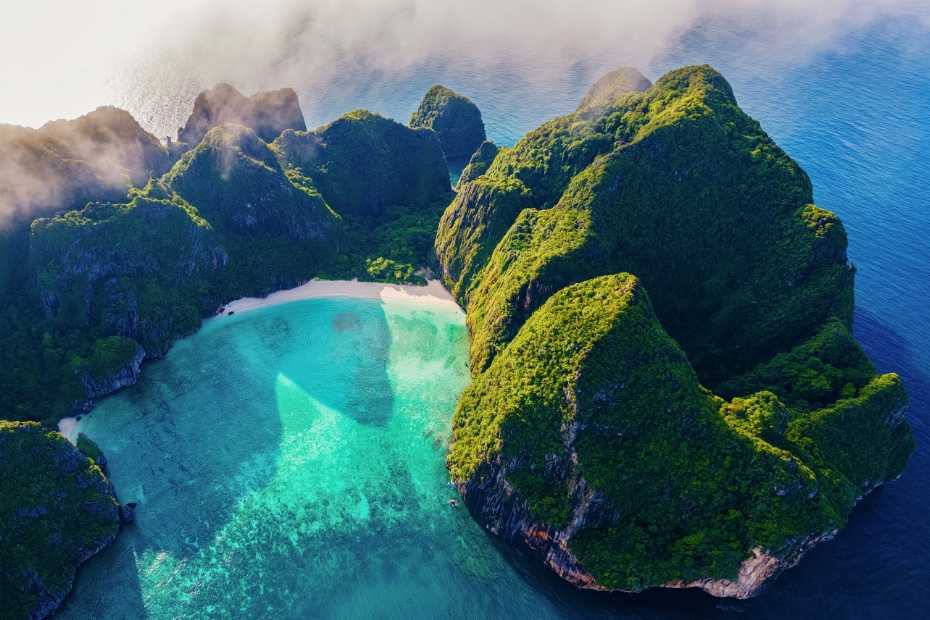
Discover Thailand’s Hidden Gems
Al-kharj: a blend of ancient wells and modern charm.
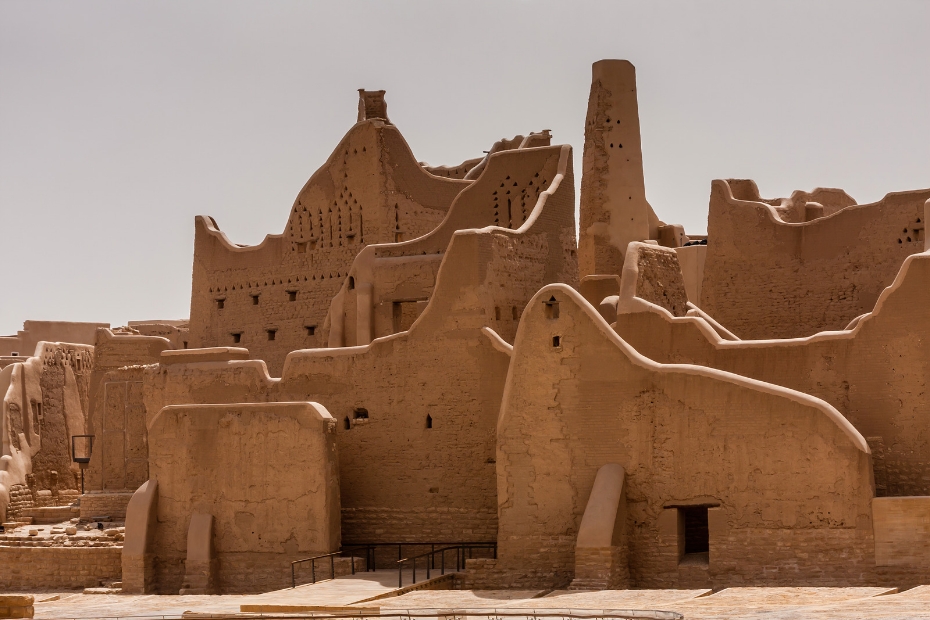
Discovering Diriyah: The Jewel of Saudi Arabia
Tribal Cultural Heritage in India
Showcasing new initiatives in education
Learn more about tribal communities in Maharashtra
Read or download the Tribal Sub-Plan in Maharashtra (PDF, 3 MB) >> In India tribal people are often called “Adivasis” and the government recognizes them as scheduled tribes (STs). Scheduled Tribes (STs) and also Scheduled Castes (SCs) are the disadvantaged sections of the society due to socio-economic exploitation and isolation since times immemorial . According to the Census of 2011, the ST population in India was 104.5 million, accounting for 8.63 percent of the total population of the country. The tribal population in Maharashtra in 2011 was 10.5 million constituting 9.35 percent of the total population of the state . The state has the second largest tribal population in the country, next only to Madhya Pradesh, with 10 percent of the total ST population of India. Numerically, Maharashtra state has the largest number of tribal population in the country . Though the ST population in India is numerically less as compared to the general population, they deserve special attention as they are socio-economically and culturally backward and isolated from the general population. Even among the STs, there are large differences between them in terms of numerical strength, history of settlement, geographic location, livelihood pattern, language, culture, human development, political empowerment and developmental aspirations . Further, each tribe is an endogamous group and interaction between groups and outside world is very much limited. […]
Source: Foreword by Dr. S. Parasuraman in “Tribal Sub-Plan in Maharashtra: A Diagnostic Study” (TATA Institute of Social Sciences, Mumbai supported by Unicef Maharashtra, December 2015) URL: https://cdnbbsr.s3waas.gov.in Date Visited: 30 June 2022
[Bold typeface added above for emphasis]
Find up-to-date information provided by, for and about Indian authors, researchers, officials, and educators
Action for Community Organisation, Rehabilitation and Development (ACCORD) – www.accordweb.in
Ashoka Trust for Research in Ecology and the Environment (ATREE) – www.atree.org
Freedom United – www.freedomunited.org
Government of India (all websites ending on “.gov.in”)
Shodhganga (a reservoir of Indian theses) – https://shodhganga.inflibnet.ac.in
Survival International – www.survivalinternational.org
Unesco – https://en.unesco.org
Unesco digital library – https://unesdoc.unesco.org
Unicef – www.unicef.org
United Nations – www.un.org/en
Video Volunteers – www.videovolunteers.org
To search Indian periodicals, magazines, web portals and other sources safely, click here . To find publishing details for Shodhganga’s PhD search results, click here >>
Combine the name of any particular state, language or region with that of any tribal ( Adivasi ) community.
Add keywords of special interest (health, nutrition endangered language, illegal mining, sacred grove); learn about the rights of Scheduled Tribes such as the “Forest Rights Act” (FRA); and the United Nations “Declaration on the Rights of Indigenous Peoples”, “Universal Declaration of Human Rights”, “women’s rights”, or “children’s right to education”.
Specify any other issue or news item you want to learn more about (biodiversity, bonded labour and human trafficking, climate change, ecology, economic development, ethnobotany, ethnomedicine, global warming, Himalayan tribe, hunter-gatherers in a particular region or state, prevention of rural poverty, water access).
For official figures include “scheduled tribe ST” along with a union state or region : e.g. “Chhattisgarh ST community”, “Scheduled tribe Tamil Nadu census”, “ST Kerala census”, “Particularly Vulnerable Tribal Group Jharkhand”, “PVTG Rajasthan”, “Adivasi ST Kerala”, “Adibasi ST West Bengal” etc.
In case the Google Custom Search window is not displayed here try the following: (1) toggle between “Reader” and regular viewing; (2) in your browser’s Security settings select “Enable JavaScript” | More tips >>

Ādivāsi [ādibāsi] may be used in accordance with local conventions; and increasingly so for official purposes (e.g. in “ Conserving Tradition and Practices of Adivasi Communities in India ” published on NIDM.gov.in ); Dr. Ivy Hansdak clarifies:
“ Adivasi – which is derived from Sanskrit – is applied to the dark-skinned or Austro-Asiatic indigenous groups of India (usually those from Eastern India). It is a commonly-used term in Jharkhand, Bihar, West Bengal and Odisha. It is also used by the local Mongoloid tribes of North Eastern India for the migrant workers who were brought in as indentured labourers to work in tea plantations during the colonial period. ‘Tribal’ is a very broad term in the English language and includes all the different indigenous groups of India. The terms ‘indigenous’ and ‘aboriginal’ are not used often as the government claims most groups are indigenous in India. ‘Denotified Tribes’ is only used for those nomadic tribes who were notified as ‘criminal tribes’ during the British Raj [colonial rule]; later they were ‘denotified’ but still bear the stigma.” (emails dated 2020 & 2023)
“Tribal groups (adivasis) in India have often been excluded, marginalized and oppressed by ‘mainstream’ society. In many ways this exclusion, marginalization and oppression is fostered by the way in which ‘mainstream’ society looks at the adivasis – as exotic, dangerous, or ‘primitive’ others.” – Ganesh [G.N.] Devy in A Nomad Called Thief: Reflections on Adivasi Silence and Voice | Classifications in different states >>
“Tribals are subject to oppression and cruelty even after independence and still picked up by the investigating officers to cover up shoddy investigations.” – D.Y. Chandrachud (Chief Justice of India since 9 November 2022) quoted in “Members of De-Notified Tribes Picked Up to Cover Up Shoddy Investigations” | Learn more >>
“Since the Indian Constitution uses the term ‘Scheduled Tribes’ or ‘tribals’ to refer to indigenous communities in India and the colloquial reference used by several indigenous communities themselves is ‘adivasis’ these two terms shall be used interchangeably.” – Rebecca S . David in “An analysis of the impact of the Forest Rights Act (2006) in three states of India” (MPhil University of Cambridge, UK, 2014), p. 1 | Learn more | Classifications in different states >>
“Adivasis are not a homogeneous group; there are over 200 distinct peoples speaking more than 100 languages, and varying greatly in ethnicity and culture.” – Source: World Directory of Minorities and Indigenous Peoples – India | Learn more | Classifications in different states >>
- Appointments
- Corporate Connect
- Discover Your India
- Explore the world
- Food Voyager
- Hotels & Resorts
- Lifestyle, Weddings & Wellness
- Today's Traveller Awards
- Today's Traveller Interviews

- Today’s Traveller Awards
- Today’s Traveller Interviews
Discover a hidden gem – Maharashtra’s tribal Warli Art
Tribal art form is a beautiful art of storytelling of a time and region and it needs to be preserved. maharashtra tourism is committed to protect, promote and support the indigenous culture and traditions..
We often come across paintings that are colourful and vibrant, depicting the livelihood, culture, tradition of indigenous communities. But how much do we know about these artisans?
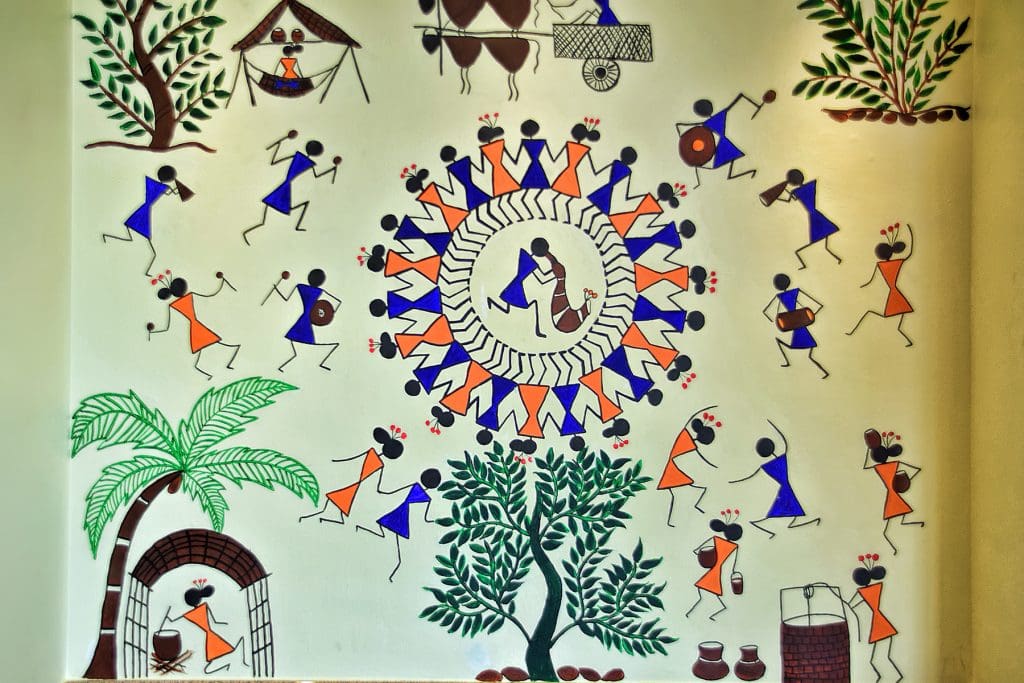
Interestingly, Maharashtra , a treasure trove of rich culture and diverse heritage, is home to several such tribal communities, making about 73.18 lakh of its population.
And unaffected by the progress made by towns and cities, these various communities have retained their unique art forms, which, though ethnic and simple, are colourful and vibrant as well.
The Warli community is the largest tribe of the Maharashtra State. They can be found majorly in Palghar, Thane and Mumbai and near the Gujarat border (Dadra & Nagar Haveli).
Warli is the dominant community in Konkan with beliefs focusing on nature. The main occupation of this community is farming as the Konkan is a region with a rich agricultural heritage.
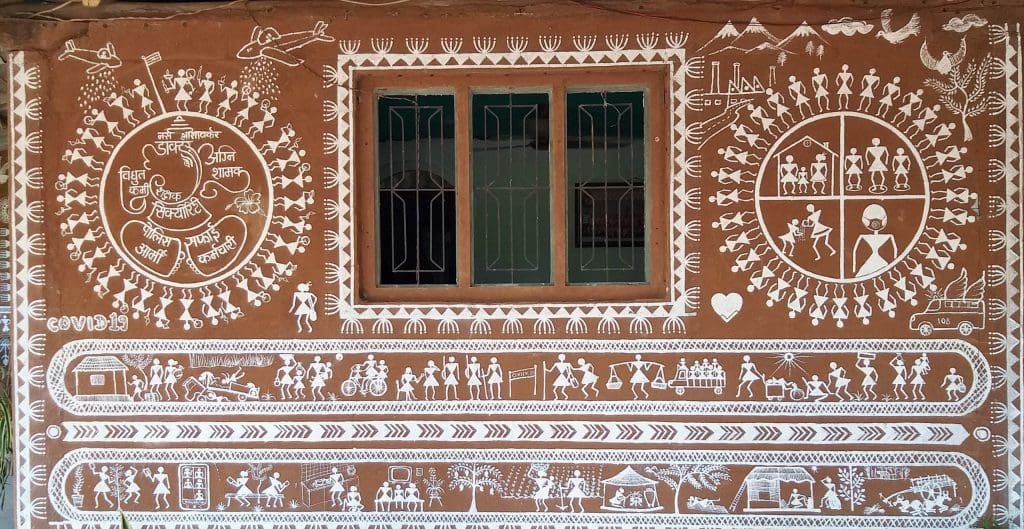
While it’s not clear about how long the Warlis have been around, Yashodhara Dalmia, an art historian and independent curator, claims in her book ‘The Painted World Of The Warlis’ that they are carrying on a tradition that dates back to 2500 to 3000 BC.
Warli art is today one of the most popular and easily recognizable traditional art forms of the State and has gained recognition among the urban population as well.
Painted in white on mud walls, with occasional dots in red and yellow, the Warli art depicts the tribe’s traditional lifestyle. Using only a circle, a triangle and a square, the monosyllabic ritual wall paintings often surrounded the themes of hunting, fishes, dances, trees and animals.
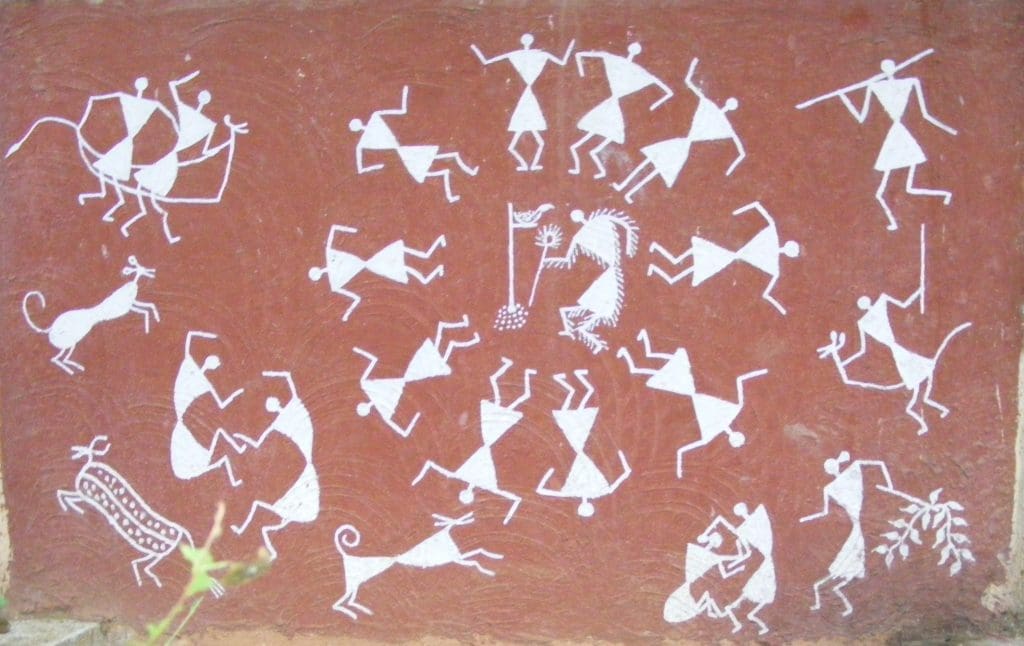
The symbolism in Warli art represents the circle of life. The triangle symbolizes mountain and trees. The square indicates a sacred enclosure for the mother goddess, symbolizing fertility, while the circle represents the sun and the moon.
The upward-facing triangle in a Warli painting represents the male while the downward-facing triangle represents the female. Human and animal bodies are represented by two triangles joined at the tip – the upper trunk and the lower pelvis.
One of the unique aspects depicted in many Warli paintings is the Tarpa dance. The Tarpa, a trumpet-like instrument, is played in turns by different village men. Men and women entwine their hands and move in a circle around the Tarpa player.
The colours for the paintings are made out of organic materials like natural gums (found in trees), clay from the mountains, rice flour etc. and the background of the canvas is painted in 3 colours: Black with charcoal, Brown with clay and Light brown with cow dung.
It usually takes 15 minutes to 2 months to complete one painting depending on the size of the canvas and the detailing of the painting. These paintings are available in a variety of canvas sizes and can be preserved for 20-30 years if they are framed properly. The paintings are now also done on paper, cloth, fabric and canvas.
Mohit Bagadia, Founder of Swadesee said, “Warli Art depicts the tribe’s culture, traditions and customs through simple shapes and figures that are derived from nature.”
He added, ” It encapsulates the daily life of tribals and this is how the art form came into existence.
Their idea was never to sell but preserve their culture through art. it was a way of life for them.”, he continued, ““another interesting aspect of this tribe is that elderly people especially widows are engaged to carry out warli paintings on the walls of newly-wed couples’ houses unlike other communities.”, this art form was called ‘suhasini’ (ever smiling). many warli paintings also represent palaghat, the marriage god and often include a bride and groom riding a horse., it is also believed that these paintings invoke the powers of the god”, he added., the warli artists have been invited to exhibit in galleries and museums around the world including the british museum and quai branly in paris..

Their paintings are part of several collections of art connoisseurs and art collectors including Foundation Cartier of Contemporary Art, Devi Art Foundation in Delhi and private collectors such as Agnés B.
Late Jivya Soma Mashe (1934-2018), an artist of Maharashtra, popularized the Warli tribal art form not only in India but abroad in places like France, Holland etc.
He was awarded padma bhushan for his artwork. he was one of the pioneers who made art on canvas., authentic warli painting on canvases can be enjoyed during a visit to the tribal cultural museum, pune to see the paintings..

Read More: Discover your India
Table of Contents
Our social presence.

- Discover India
- Hotels & Resorts
- Lifestyle, Weddings & wellness
- Todays Traveller awards
- Todays Traveller Interviews
Quick Links
Our social networks.
- SHIVAA Supporters
- News Articles
- Success Stories

- Upcoming Events
- YouTube Videos
- Collaboration
Empowering Tribal Communities in Maharashtra: A Journey of Hope and Transformation
Tribal communities in Maharashtra, India, have long been marginalized and faced discrimination. They have limited access to education, healthcare, and employment opportunities. As a result, they are often trapped in a cycle of poverty and deprivation.
Challenges faced by the tribal communities in Maharashtra
- Poverty: Tribal communities are among the poorest in Maharashtra. According to the 2011 census, the poverty rate among tribal communities in Maharashtra was 47%, compared to the state average of 25%.
- Illiteracy: The literacy rate among tribal communities in Maharashtra is low. According to the 2011 census, the literacy rate among tribal communities in Maharashtra was 53%, compared to the state average of 77%.
- Unemployment: The unemployment rate among tribal communities in Maharashtra is high. According to the 2011 census, the unemployment rate among tribal communities in Maharashtra was 11%, compared to the state average of 6%.
Initiatives taken by the government to empower tribal communities in Maharashtra
The government of Maharashtra has taken a number of initiatives to empower tribal communities in the state. These initiatives include:
- The Tribal Sub-Plan (TSP): The TSP is a centrally-sponsored scheme that aims to ensure that a certain percentage of the government budget is allocated to the development of tribal communities.
- The Scheduled Tribes and Other Backward Classes (Reservation) Act, 1993: This act provides for reservation in education and employment for tribal communities.
- The Forest Rights Act, 2006: This act recognizes the rights of tribal communities to their traditional forest lands.
The government’s initiatives have had a positive impact on the lives of tribal communities in Maharashtra. For example, the TSP has led to an increase in the allocation of funds for tribal development. The Scheduled Tribes and Other Backward Classes (Reservation) Act, 1993 has led to an increase in the representation of tribal communities in education and employment. The Forest Rights Act, 2006 has empowered tribal communities to manage their traditional forest lands.
Challenges that remain
Despite the progress that has been made, there are still many challenges that remain. For example, the quality of education and healthcare services in tribal areas is often poor. There is also a lack of awareness among tribal communities about their rights.
The way forward
The way forward is to continue to invest in the development of tribal communities. This includes investing in education, healthcare, and infrastructure. It is also important to raise awareness among tribal communities about their rights.
The empowerment of tribal communities in Maharashtra is a journey of hope and transformation. The government has taken a number of initiatives to empower tribal communities, and these initiatives have had a positive impact on the lives of tribal people. However, there are still many challenges that remain. The way forward is to continue to invest in the development of tribal communities and to raise awareness among tribal communities about their rights.
Stories of hope
There are many stories of hope and transformation from tribal communities in Maharashtra. For example, one tribal community in the state has set up a collective farming enterprise that has helped to improve the livelihoods of its members. Another tribal community has set up a school that is providing education to children from the community. These are just a few examples of the many ways in which tribal communities in Maharashtra are working to improve their lives.
The future of tribal communities in Maharashtra
The future of tribal communities in Maharashtra is bright. The government is committed to empowering tribal communities, and there is a growing movement among tribal communities to assert their rights. With continued investment and support, tribal communities in Maharashtra can achieve their full potential.
I hope this blog has been informative. Please let me know if you have any questions.
In addition to the information in the blog, I would also like to add that the following are some of the key factors that have contributed to the empowerment of tribal communities in Maharashtra:
- The growth of the self-help group (SHG) movement: SHGs have empowered tribal women by providing them with access to credit and training.
- The rise of tribal entrepreneurs: There has been a growing number of tribal entrepreneurs in Maharashtra who are starting their own businesses.
- The increasing political participation of tribal communities: Tribal communities are increasingly participating in the political process and are demanding a voice in the decisions that affect their lives.
I believe that these factors will continue to play a role in the empowerment of tribal communities in Maharashtra in the years to come.
Share this post
Leave a reply cancel reply.
Your email address will not be published. Required fields are marked *
Save my name, email, and website in this browser for the next time I comment.
Related Posts
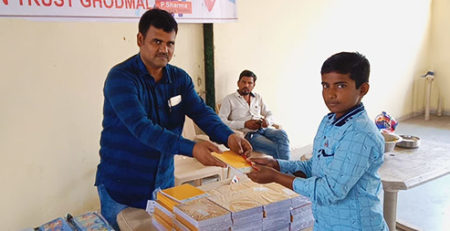
Challenges that tribal children face while getting education
How often has your child complained about not liking the food... read more
Difference Between Suburban and Rural – By Shivaa NGO
The Environment: Each people exists within somebody's and physical environment that surround us. The human environment includes... read more

6 Simple & Easy Ways To Help The Environment: At Home and At Work
Many people are searching for quick and simple ways in which... read more
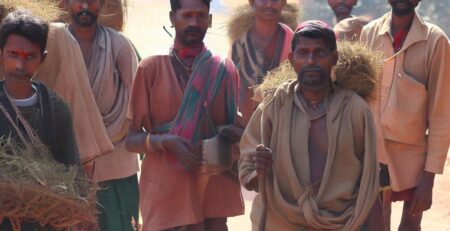
NGO’s Working for Tribals in India – By Shivaa NGO
NGOs Working for Tribals in India At present, there are many Non-Governmental... read more
The Benefits of Agro Tourism for Local Communities – By SHIVAA NGO
Wada is a taluka in the Palghar district of Maharashtra, India.... read more
How an NGO Helps Children To Build Up Their Lives- By SHIVAA NGO
A large number of youngsters in India die per annum thanks... read more
Ideal Fertilizer For Home Gardening Plants -By SHIVAA NGO
A discussion on fertilizer for home gardening plants looks as if... read more
The History of Yoga – Where Did Yoga Come From- By SHIVAA NGO
No one knows exactly how old yoga is. It originated as... read more
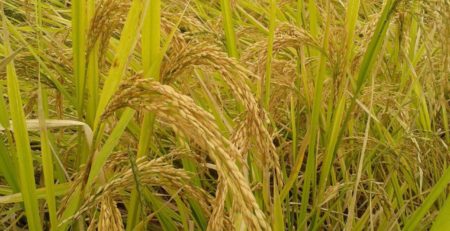
The impact of processed foods vs the benefits of organic farm produce
There is a lot of confusion regarding which food is good... read more
Staying Strong In Crisis – By Shivaa NGO
As I write this, we've got all been asked to shelter... read more
- Logout Login
- Adventure Holidays
- Weekend Getaways
- Driving Holidays
- Travel News
Top Searches
Ahmedabad Travel
Music Concerts
Gujarat Travel
Himachal Pradesh Waterfalls
Google Summer Destinations
Beautiful Europe Bridges
Maharashtra government to train tribal youth as tourist guides’
Times of India TIMESOFINDIA.COM / TRAVEL NEWS , MAHARASHTRA / Created : Jul 31, 2021, 11:59 IST
You're Reading
The Directorate of Tourism (DoT), Maharashtra has announced plans to train tribal youth as tourist guides in the state as part of empowering tribal youngsters to take up jobs in the tourism sector. The government will also give fr … Read more
The Directorate of Tourism (DoT), Maharashtra has announced plans to train tribal youth as tourist guides in the state as part of empowering tribal youngsters to take up jobs in the tourism sector. The government will also give free training to them. The programme is all set to launch in Raigad district of Maharashtra along with the Indian Institute of Tourism and Travel Management (IITTM). It is an autonomous body under the Ministry for Tourism, India. Read less
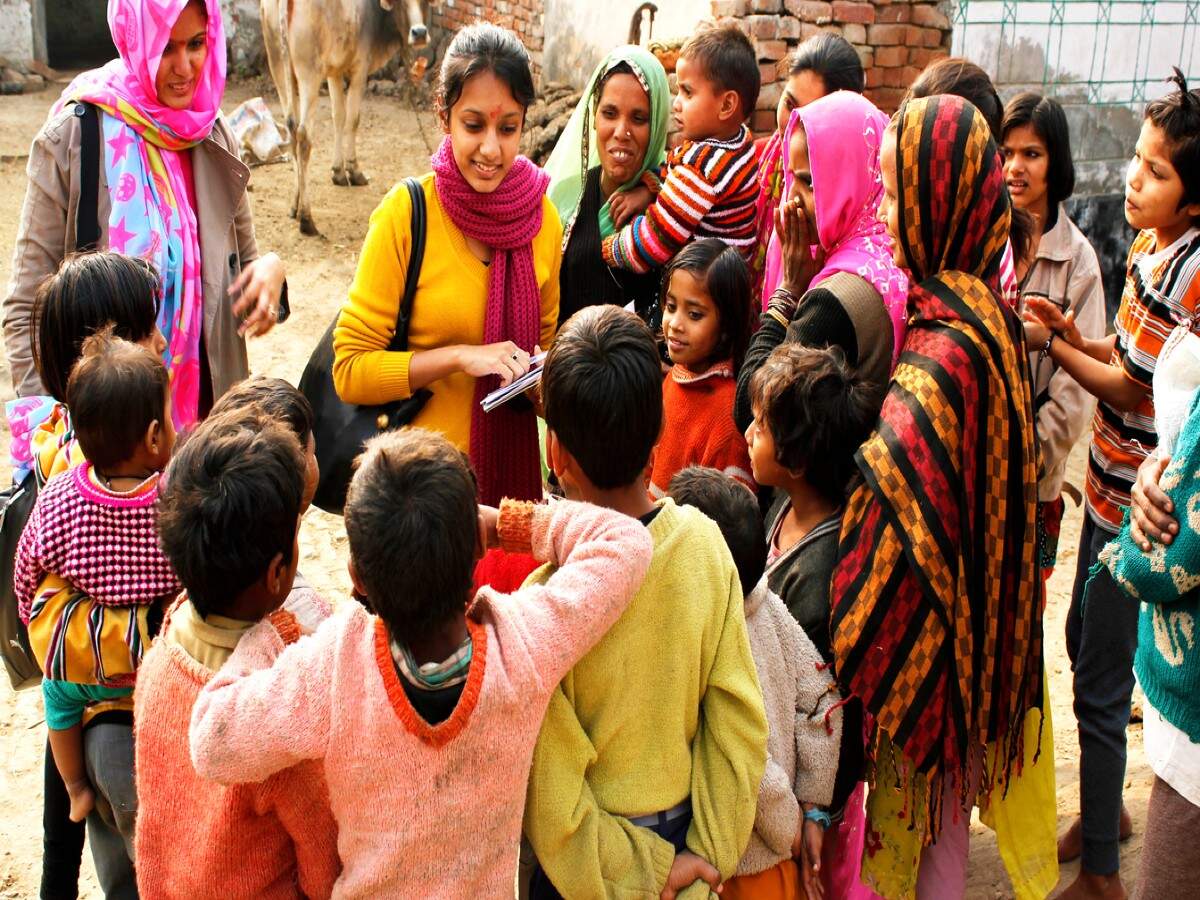
More from Travel News

Comments (0)

Refrain from posting comments that are obscene, defamatory or inflammatory, and do not indulge in personal attacks, name calling or inciting hatred against any community. Help us delete comments that do not follow these guidelines by marking them offensive . Let's work together to keep the conversation civil.
Comments ( ) Sort: Newest UpVoted Oldest Discussed Down Voted closecomments

SIGN IN WITH
Or post without registration.

Visual Stories
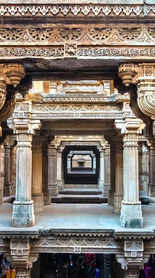
Popular Galleries

Top music concerts worth travelling for in 2024: The Rolling Stones, Coldplay, and more TRAVEL TRENDS , WORLD

5 beautiful bridges to cross in Europe TRAVEL TRENDS , WORLD

Gujarat's 7 not-so-secret places worth travelling to TRAVEL TRENDS , GUJARAT
Trending stories.
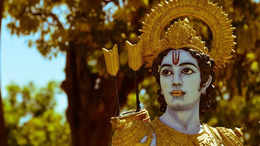
Ram Navmi special: 8 Ram temples to visit in India

- Vrindavan to soon have a 70-storey skyscraper temple to boost tourism

Gujarat's 7 not-so-secret places worth travelling to

Top music concerts worth travelling for in 2024: The Rolling Stones, Coldplay

What is a Green Card? Advantages of a Green Card and who can apply
- 1 Maharashtra government to train tribal youth as tourist guides’
- 2 India: Scheduled international flights banned till August 31
- 3 Saudi Arabia to welcome fully vaccinated foreign travellers from August 1
- 4 Travel restrictions in the US will not end until the delta variant threat subsides
- 5 Saudi Arabia all set to open for vaccinated travellers from August 1

THE DEFINITIVE GUIDE TO DESTINATIONS, ITINERARIES, THINGS TO DO, RESTAURANTS, NIGHTLIFE and LOTS MORE!
FOLLOW US ON
Places to visit.
- Places to visit in Bangalore
- Places to visit in Mumbai
- Places to visit in Delhi
- Places to visit in Goa
- Hotels in Goa
- Hotels in Jaipur
- Hotels in Shimla
- Hotels in Mumbai
Things To do
- Things to do in Goa
- Things to do in Mumbai
- Things to do in Bangalore
- Things to do in Delhi
Travel Inspiration
- Visa on arrival for Indians
- Honeymoon Places in india
- Hill Stations in India
- Weekend getaways in Mumbai
- Weather in Delhi
- Weather in Chennai
- Weather in Bangalore
- Weather in Mumbai
Best Beaches
- Goa Beaches
- Mumbai Beaches
- Pondicherry Beaches
- Kerala Beaches
- Restaurants in Bangalore
- Restaurants in Chennai
- Restaurants in Pune
- Restaurants in Jaipur
- Hill Station near Delhi
- Winter trip to Ladakh
- Places to visit in Kerala
- Winter Honeymoon Destinations
- UK visa guide for Indians
- Winter Trip to Manali
- Vaishno Devi Yatra
- Special Train Ticket Booking
- HP inter-state Bus
- Honeymoon Destinations India
Latest News
- Saudi Arabia: Deserts around Mecca and Medina are turning green due to heavy rainfall
Congratulations!
You have been successfully added to the mailing list of Times of India Travel. To complete the subscription process, kindly open your inbox and click on the confirmation link which has been emailed to you.
Share with friends
Thank You for sharing! Your friend will receive the article link on email mentioned.
- (For more than one recipient, type addresses separated by commas)
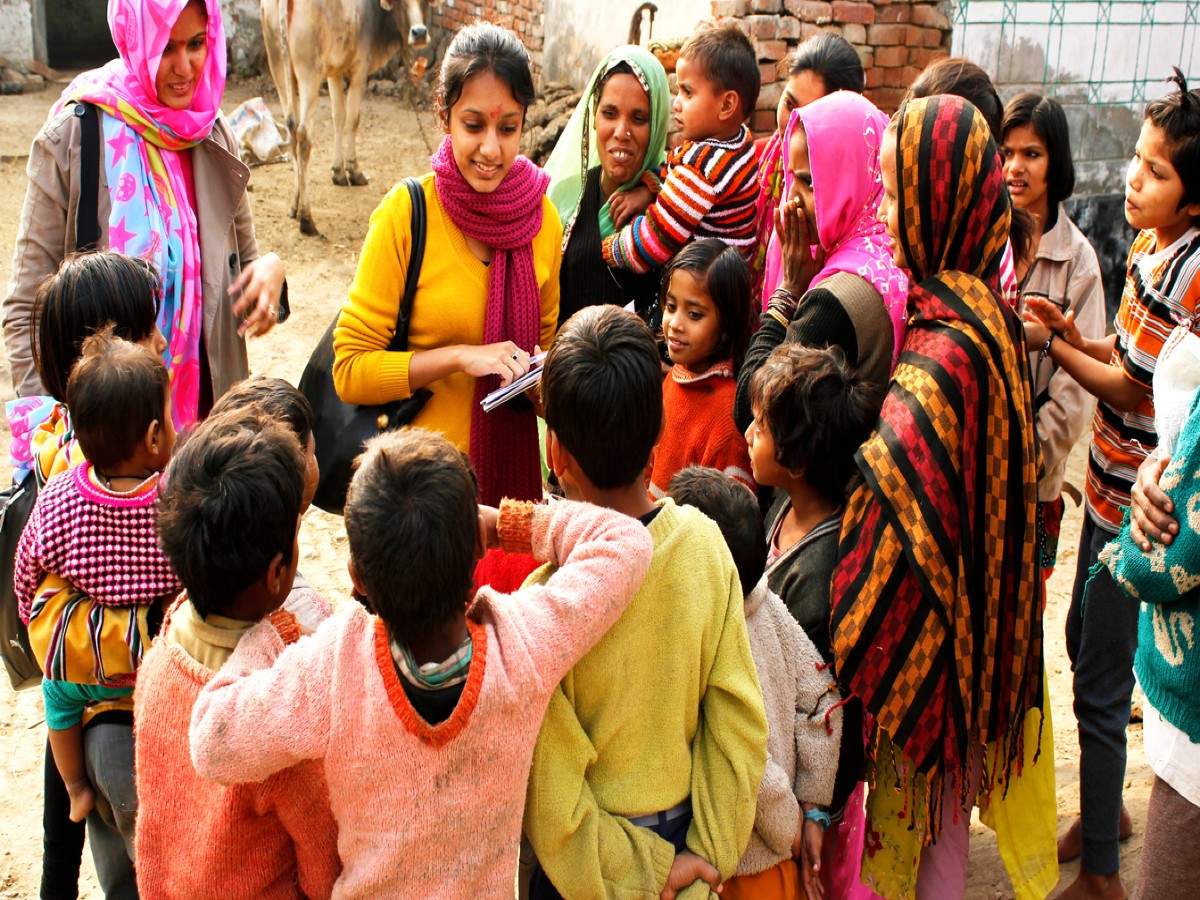
The Directorate of Tourism (DoT), Maharashtra has announced plans to train tribal youth as tourist guides in the state as part of empowering tribal youngsters to take up jobs in the tourism sector. Th...
We have updated our terms and conditions and privacy policy Click "Continue" to accept and continue with ET TravelWorld
We use cookies to ensure best experience for you
We use cookies and other tracking technologies to improve your browsing experience on our site, show personalize content and targeted ads, analyze site traffic, and understand where our audience is coming from. You can also read our privacy policy , We use cookies to ensure the best experience for you on our website.
By choosing I accept, or by continuing being on the website, you consent to our use of Cookies and Terms & Conditions .
- Leaders Speak
- Brand Solutions
- Tribal youth to be given tourist guides’ training in Maharashtra
The programme will be launched in Raigad in Maharashtra with the support of Indian Institute of Tourism and Travel Management (IITTM), an autonomous body under the Ministry for Tourism, Government of India.
- ETTravelWorld
- Published On Jul 31, 2021 at 10:29 AM IST

- Updated On Jul 31, 2021 at 10:29 AM IST
All Comments
By commenting, you agree to the Prohibited Content Policy
Find this Comment Offensive?
- Foul Language
- Inciting hatred against a certain community
- Out of Context / Spam
Join the community of 2M+ industry professionals
Subscribe to our newsletter to get latest insights & analysis., download ettravelworld app.
- Get Realtime updates
- Save your favourite articles
- ministry for tourism
- dot maharashtra
- Maharashtra
- tour guides

Warli Art of Maharashtra
History of warli art.
The expression ‘Warli’ is derived from ‘Warli’ which stands a piece of land and these are symbolized in inconspicuous approach. 2. At the same time as there are no accounts of the correct origins of the Warli art, its origins may be outlined to as early as the 10th century AD. 3. Research highlights that the warli tribes are the proliferators of a tradition which originated for a moment in the Neolithic period between 2,500 BC and 3,000 BC.
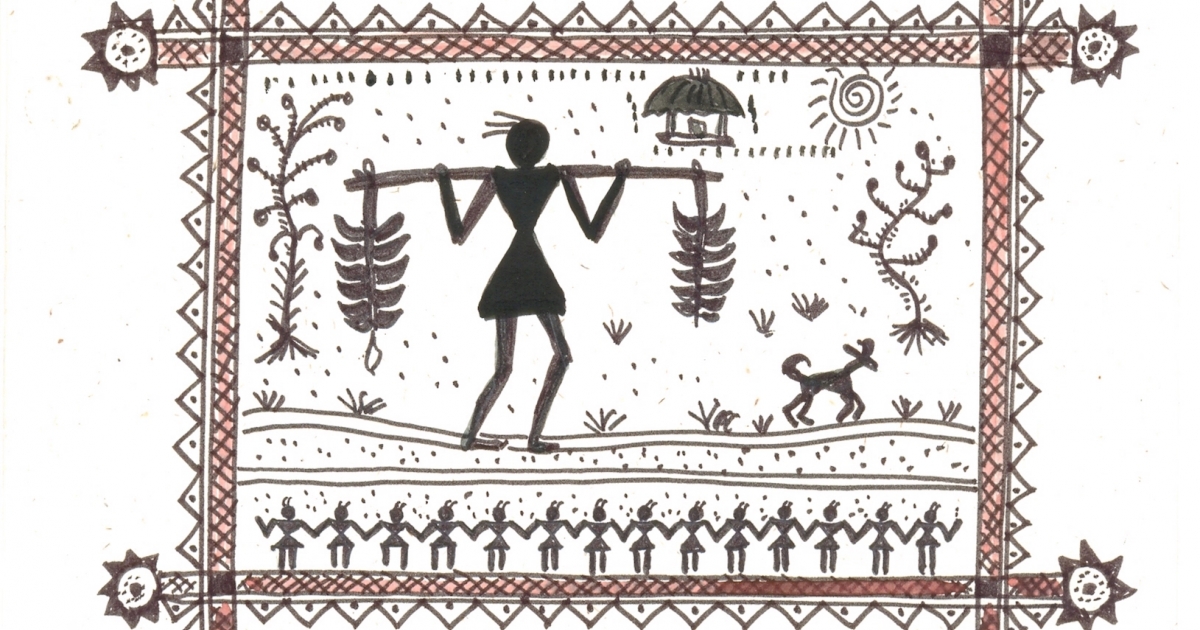
Warli Art as a FOLK ART
The Warli art is a good-looking folk art of Maharashtra. It is conventionally shaped by the tribal women and was first investigated in the early seventies and afterward it was recognised as ‘Warli art’. However, tribal people articulate themselves in glowing traits from side to side paintings which they carry out on the walls of their house and was the merely means of broadcasting folklore to the public not familiar with the written word. Warli paintings were primarily done by the women. The mainly significant facet of the image is that it does not represent mythological characters of deities, but portray social life.
Verbal communication of Warli Tribe
Warli tribes are forest-dwellers except have made a measured evolution towards being a rural group of people and inhabit in the West coast of Northern Maharashtra. A great attentiveness is originated in the Thane district of Mumbai. A modest underdeveloped inexpensively, they still uphold their home-grown ideas, customs and traditions. They are extensive in the villages for instance Cosbad, Dahanu, Jawahar, Jamshed, Manor, Mokhada, Palghara, Talasari, Raitali, Vikramgad, Vada and more than a few other parts of the district as well.
A Fleeting Look
The warli art is an indissoluble part of tribal existence and is a representation of the cultural distinctiveness and inheritance. It is an impulsive sign, without any affectations. The pleasurable moments in their uncomplicated life, their cultural fiestas, all discover look on the thatched walls in their art. The very images basically of the paintings have been dances, wedding processions, coconut and palm trees, rice fields and tribal Gods. Warli Painting is more often than not done with rice gruel on the walls which is than plastered with dung and soil.
Warli Art Form of Maharashtra
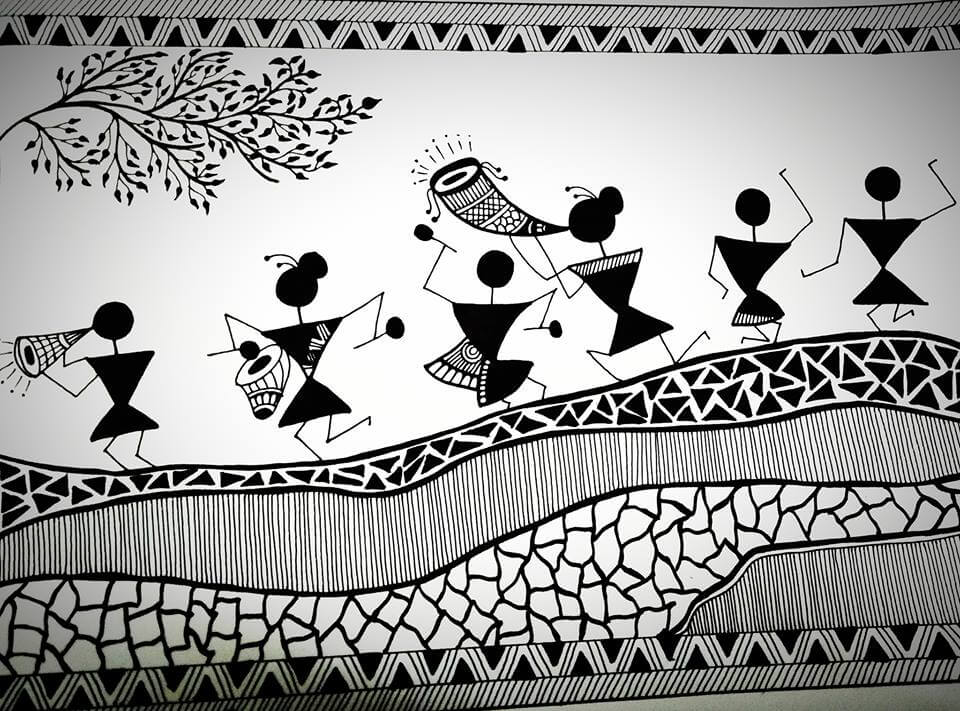
www.tribaltoursinindia.com © All Rights Reserved, 2021

IMAGES
COMMENTS
Community Tourism initiatives promote socio-economic development of the members of tribes. Through community tourism activities, more than 50% of the households in the 3 participating villages was able to achieve a growth rate of 25-35% of their household income. The migration from the villages was reduced by 25%, as well as their culture ...
Tribal tourism allows visitors to learn about these varied cultures and their traditions. The tribal trips in India are extremely revitalizing and energizing. ... Maharashtra: Maharashtra is one ...
The third largest and one of the most widely distributed tribal groups in India, the Bhil inhabit remote and, often inaccessible areas. They are divided into the Central or 'pure' Bhil and the Eastern or part-Rajput Bhil. Their name is a derivative of the word 'billee', which stands for 'bow', their most important weapon.
On your Mumbai sightseeing tour, don't miss the chance to immerse yourself in the fascinating world of Maharashtra's tribal culture. ... Explorism began as a seed initiative to build an organisation for promoting and encouraging women's empowerment in tourism. According to a report from the World Travel and Tourism Council (WTTC) in April ...
Bhil, Gond-Madia, Katkari, Koli, Oraon, Warli are the major tribes of Maharashtra. A greater part of the tribes still follows the primitive characters. They live in groups moving from one place to another in caravans in search of livelihood. Their dress, dialect, folklore, customs and practices exhibit that they have a rich cultural heritage ...
Let's go on a captivating journey to seven of the best archaeological sites in Maharashtra, each holding its own unique charm and historical significance. 1. Elephanta Caves: A Marvel of Ancient Rock-cut Architecture. Located on Elephanta Island in Mumbai Harbor, the Elephanta Caves are an exquisite example of ancient Indian rock-cut architecture.
It is known as one of the places to receive highest rainfall in the state and for its Warli paintings. It is a village in tribal district of Palghar, in northern Maharashtra. It has 95% tribal population, with 30-40 types of tribes. They are deeply rooted to their culture, and exist in harmony with nature.
Tribal Tourism is connected with tribal culture, values and traditions, tourism products owned and operated by tribal people. Tribal Tours in India read more. TRIBAL TOURS IN INDIA. CHOOSE YOUR DESTINATIONS. ... Maharashtra has a large tribal population of almost 50 tribes. These tribal communities prefer to live in self-imposed isolation ...
Welcome to Tribal Development Department, Maharashtra. ... Tribal Development Department Recruitment -2023 . जाहिरात . Read more. More News from same category . अनुसूचित जमाती प्रमाणपत्र तपासणी ऑनलाईन करण्यासाठी आदि प्रमाण ...
Puri is the best place to arrange tribal tours. Tours run for at least five nights, due to the amount of travel involved. Tours: Heritage Tours operates a 7-day Tribal Wonders tour. Also try community-based Grass Routes Journeys in Puri, which run 13-day tribal trail tours.
Tribal tourism in India has witnessed significant growth in recent years, driven by an increased interest in the country's rich cultural heritage and a desire to explore its diverse indigenous communities. ... Warli Tribe, Maharashtra: The Warli tribe is famous for its distinctive geometric art, known as Warli paintings. These paintings ...
The tribal population in Maharashtra in 2011 was 10.5 million constituting 9.35 percent of the total population of the state. The state has the second largest tribal population in the country, next only to Madhya Pradesh, with 10 percent of the total ST population of India. Numerically, Maharashtra state has the largest number of tribal ...
Maharashtra has a large tribal population. The state is home to almost 50 tribes, with the main ones being Bhils, Gonds, Mahadeo Kolis, Pawras, Thakurs and Warlis. The Warlis Various tribes, including the Warlis, live in the rough and rugged terrain of the Sahyadri Hills. Physically, they tend to be short and scrawny with dark complexions.
Tribal art form is a beautiful art of storytelling of a time and region and it needs to be preserved. Maharashtra Tourism is committed to protect, promote and support the indigenous culture and traditions. We often come across paintings that are colourful and vibrant, depicting the livelihood, culture, tradition of indigenous communities.
Volume 7, Issue 2 ( I): April - June, 2020. 87. ISSN 2394 - 7780. INTRODUCTION TO TRIBAL TOURISM IN INDIA. Divyajit. Assistant Professor, Tourism & Hospitality Manag ement Department, Mandsaur ...
The rise of tribal entrepreneurs: There has been a growing number of tribal entrepreneurs in Maharashtra who are starting their own businesses. The increasing political participation of tribal communities: Tribal communities are increasingly participating in the political process and are demanding a voice in the decisions that affect their lives.
The second most populous state in India, Maharashtra, is an ethereal state defined by its sundry mountains, panoramic beaches, breathtaking sceneries and a wide array of museums, monuments and forts that stand as a testimony to the illustrious, rich history of India. Not to mention that these make tourism in Maharashtra interesting and indulging.
To leverage India's rural heritage in creating a vibrant and responsible tourism segment by creating engaging rural experiences thereby promoting indigenous jobs, and preserving local culture and heritage. ... Tribal tourism. Shri Ajay Bhatt @AjaybhattBJP4UK Hon'ble Minister of State for Tourism, ... Maharashtra . Talao Village, Haryana ...
The Directorate of Tourism (DoT), Maharashtra has announced plans to train tribal youth as tourist guides in the state as part of empowering tribal youngsters to take up jobs in the tourism sector.
The Directorate of Tourism (DoT), Maharashtra, as part of empowering tribal youth to take up jobs in the tourism sector will give free training for tourist guides to them.The programme will be launched in Raigad in Maharashtra with the support of Indian Institute of Tourism and Travel Management (), an autonomous body under the Ministry for Tourism, Government of India.
„Tribal tourism‟ as defined by Terry Ward, journalist and travel writer, is "a new form of ... Chhatisgarh, Gujarat, Maharashtra, and Rajasthan. Tankesh Joshi and Muktesh Joshi (2010), in their study "A new aspect for Economic sustainability among tribes of
The Warli art is a good-looking folk art of Maharashtra. It is conventionally shaped by the tribal women and was first investigated in the early seventies and afterward it was recognised as 'Warli art'. However, tribal people articulate themselves in glowing traits from side to side paintings which they carry out on the walls of their house ...
The Directorate of Tourism (DoT), Government of Maharashtra, in association with Indian Institute of Tourism and Travel Management (IITTM), an autonomous under Ministry for Tourism, Government of ...